While the official coins of the late Republic were still minted under the control of the moneyers, it became more and more common practice for imperators to coin their own money to pay their troops and for propaganda purposes.
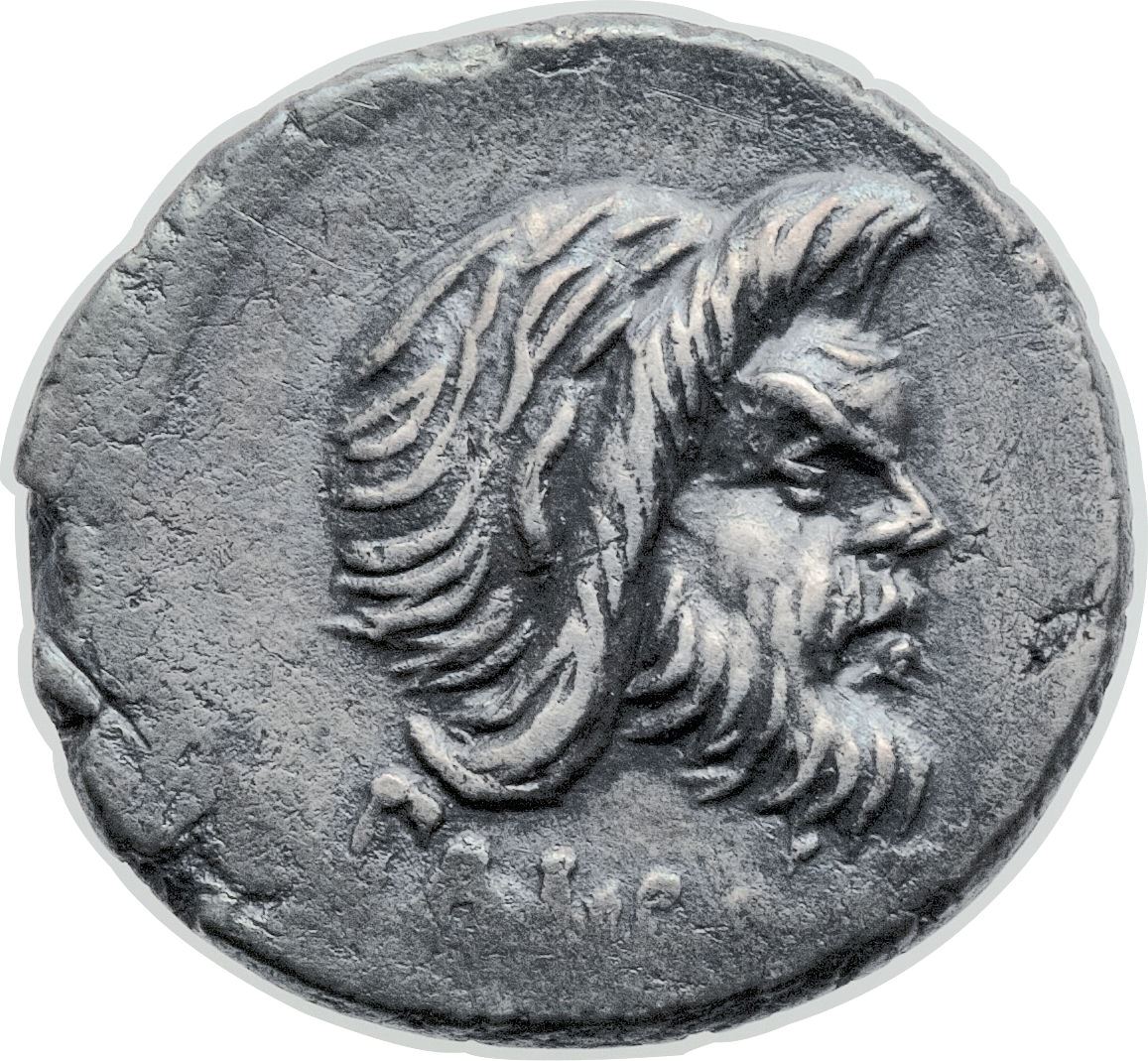
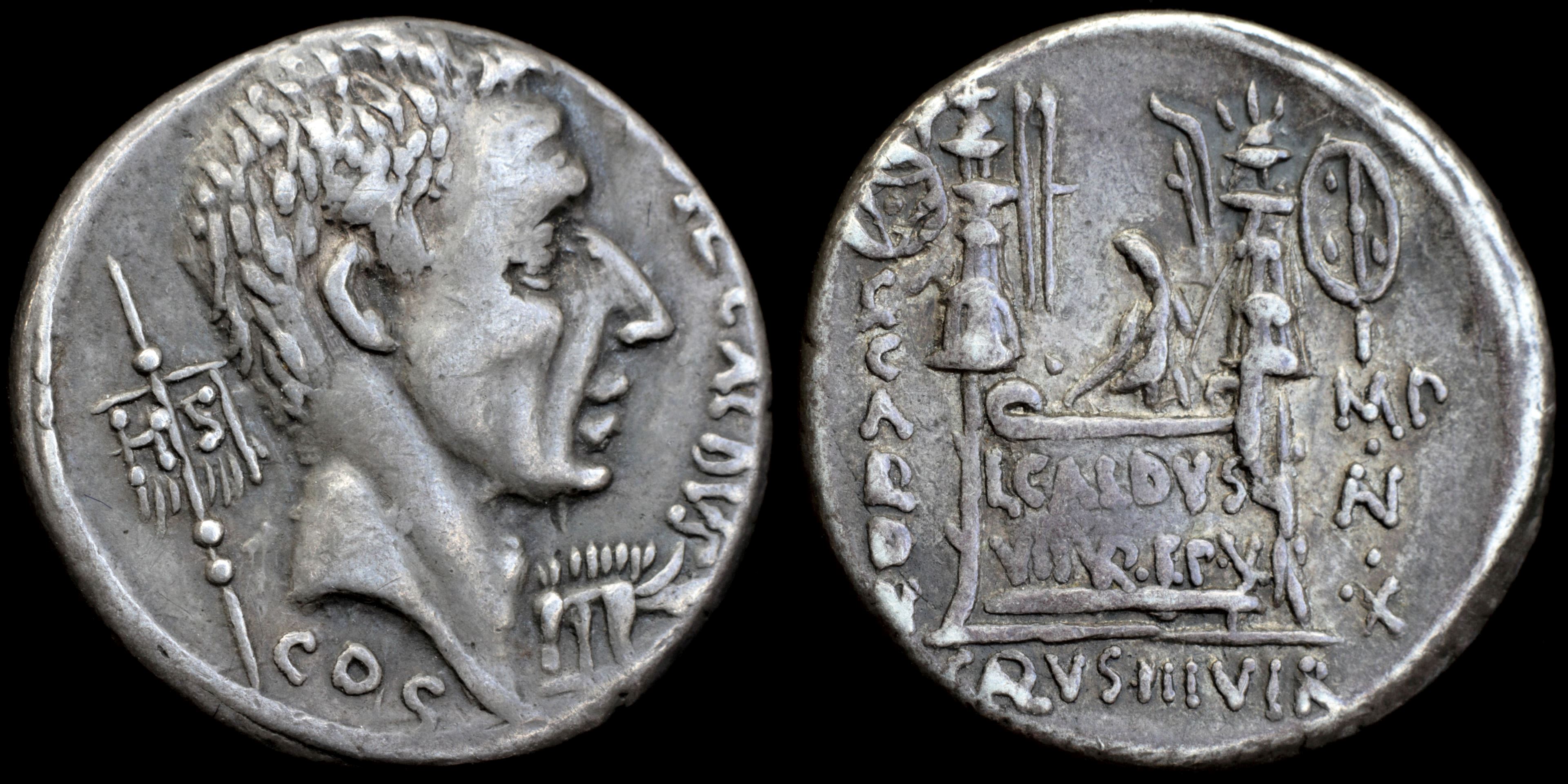
Reverse: statue of god seated left between two trophies of arms, all on a high lectisternium with front inscribed L·CALDVS / VII·(VIR)·EP(VL) (Lucius Caldus Septemvir Epulo), C·CALDVS on left, IMP·(AV)·X (Imperator Augur Decemvir) on right, C(ALD)VS III VIR below
Die Orientation: -
Weight: 3.9 g
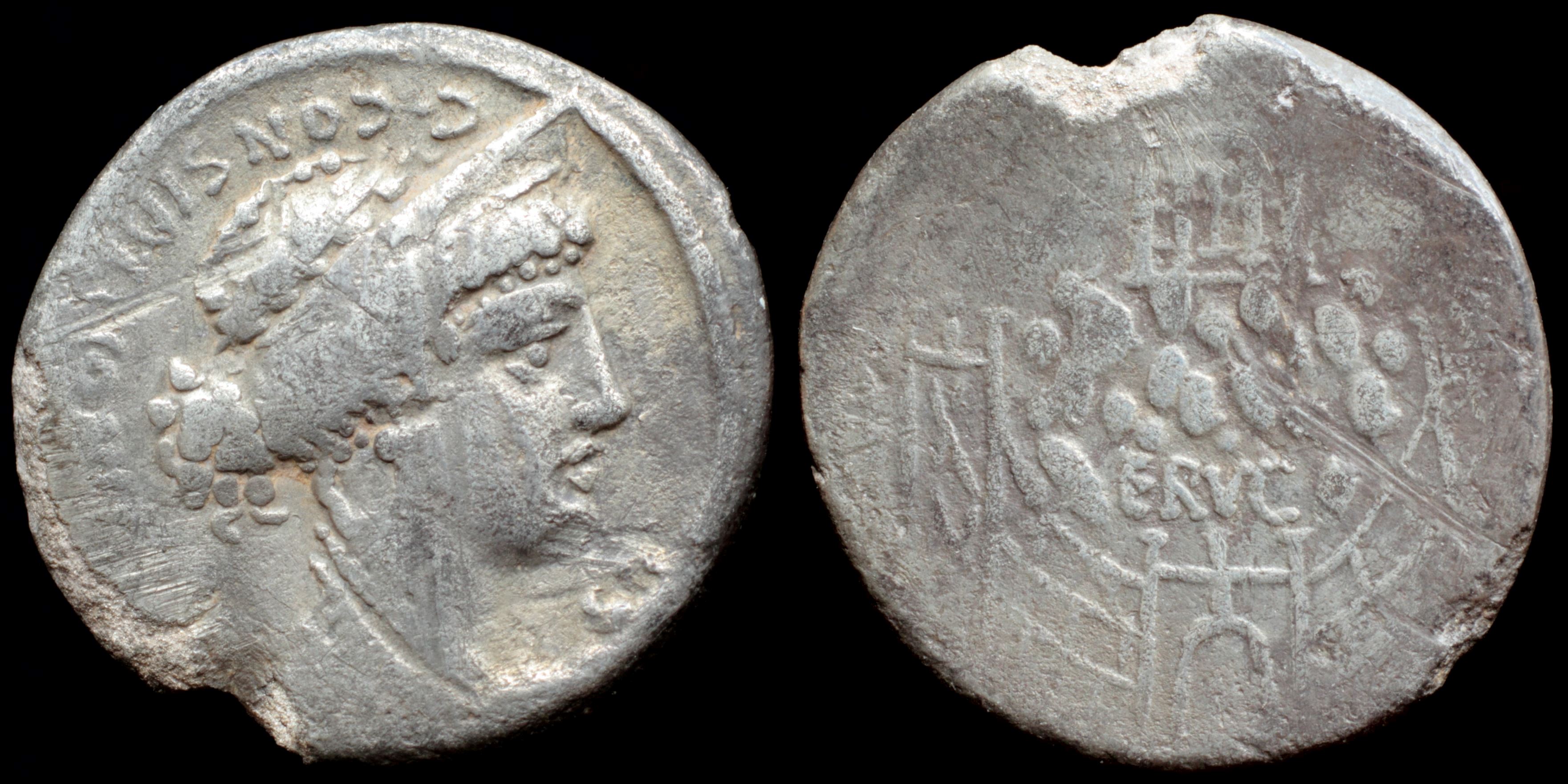
Reverse: tetrastyle temple of Venus Erycina on the top of mount Eryx, Porta Collina (place of Sulla's great victory)*, ERVC
Die Orientation: -
Weight: 3.6 g
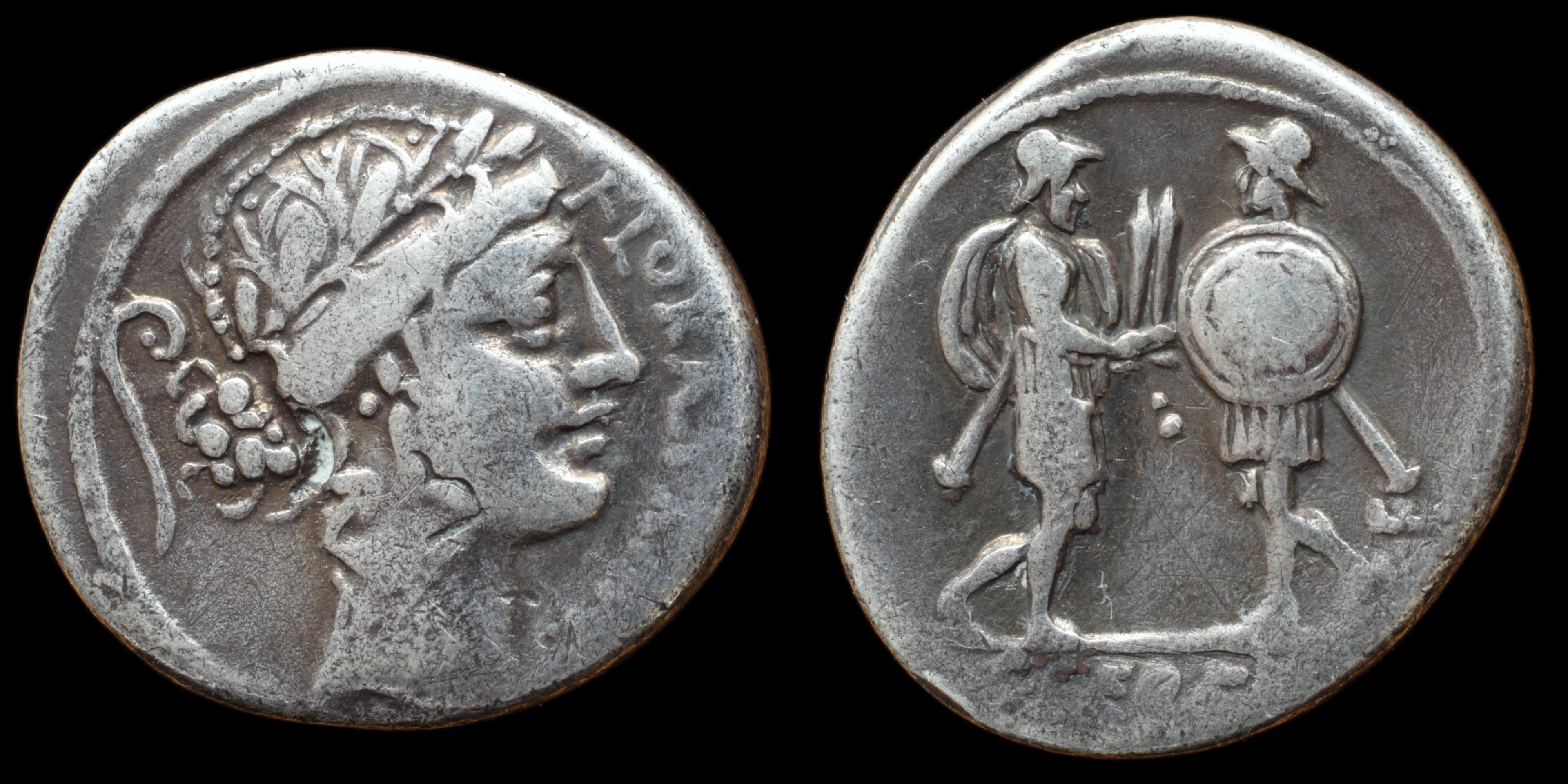
Reverse: Two soldiers facing each other, each holding shield and sword upright; C·F C·SE(RVE)IL·
Die Orientation: -
Weight: 3.7 g
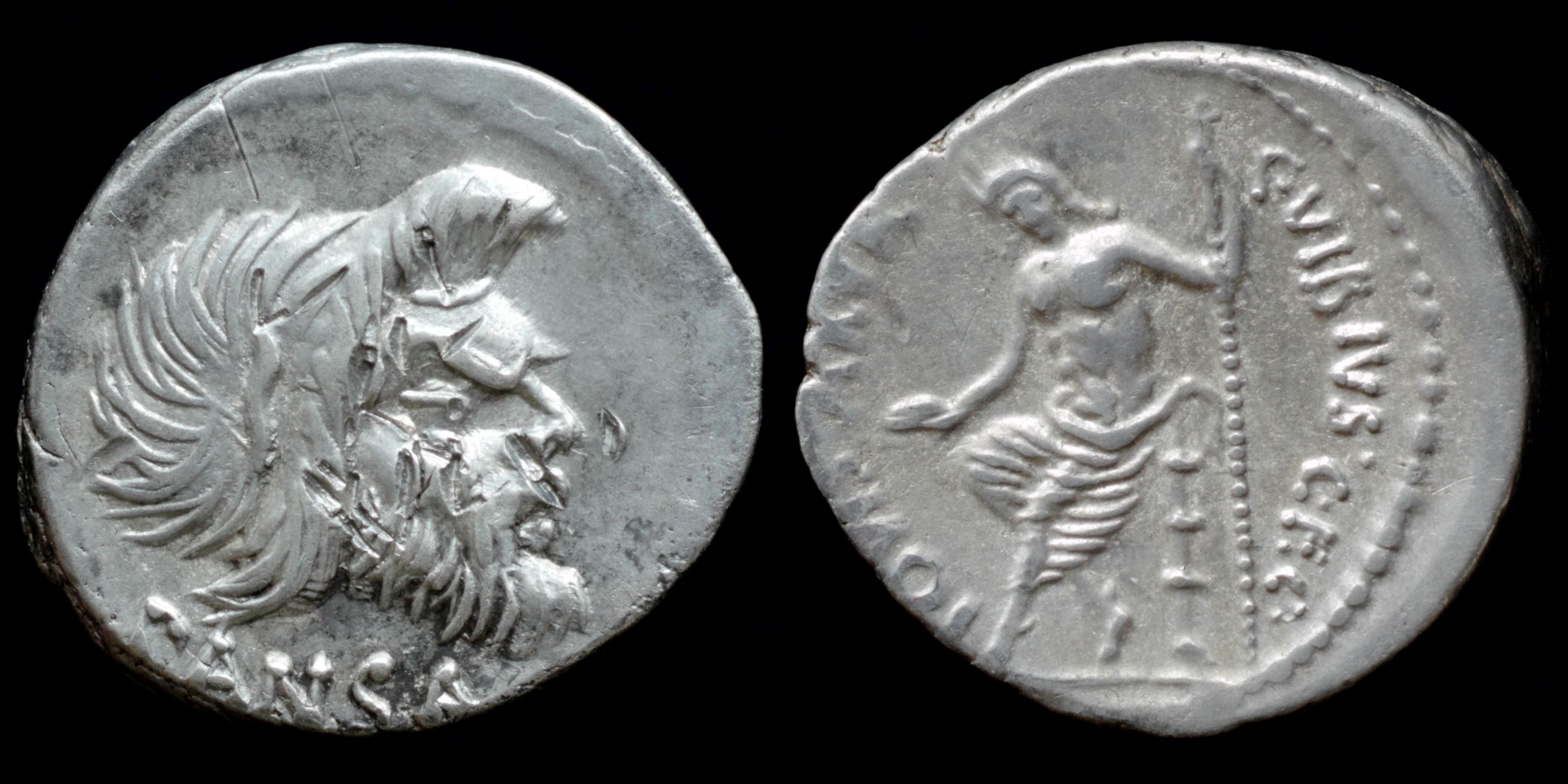
Reverse: radiate Jupiter Axurus seated left, holding patera and long scepter, IOVIS·AXVR· C·VIBIVS·C·F·C·N
Die Orientation: -
Weight: 3.9 g
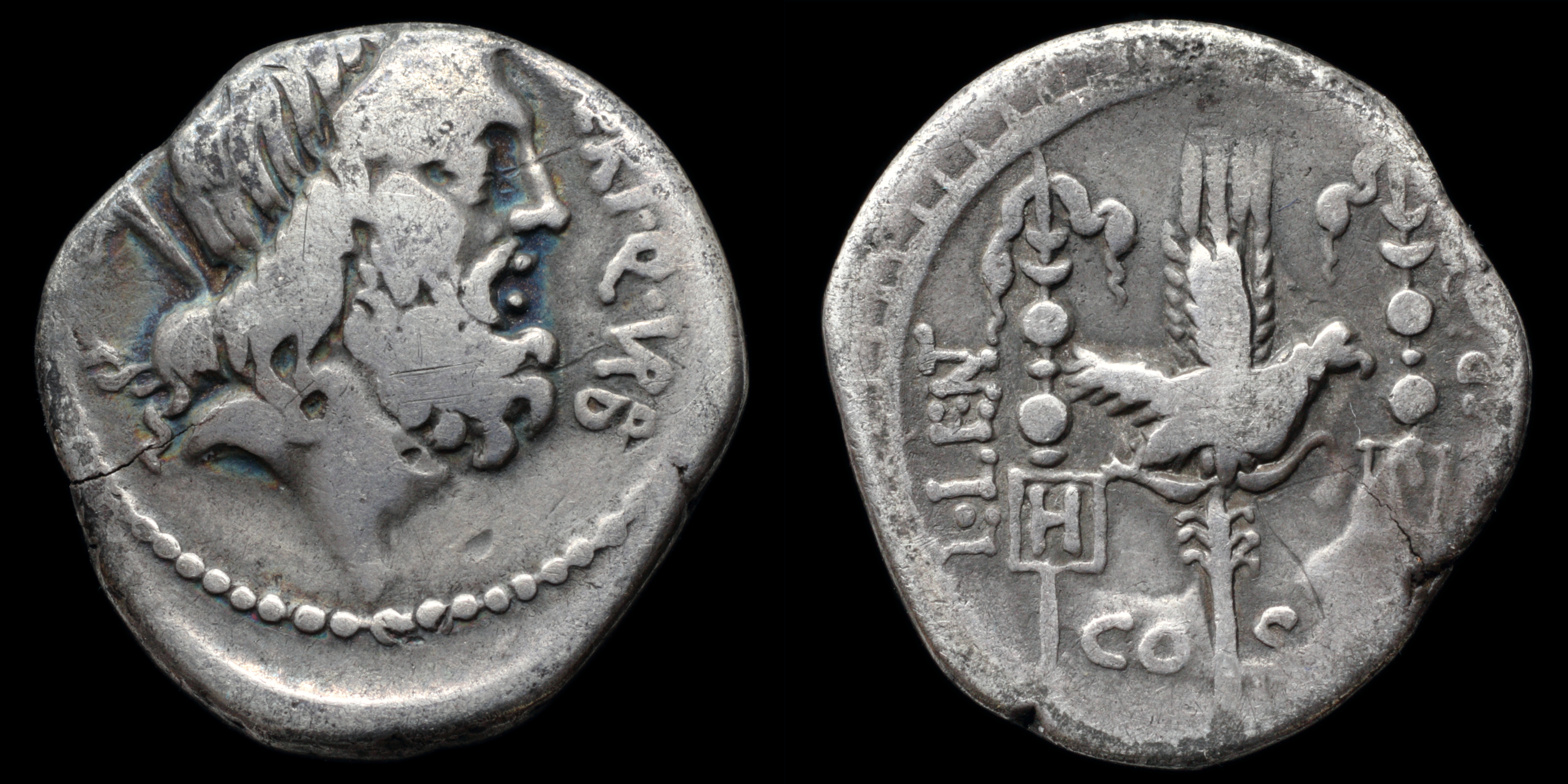
Reverse: aquila between signum of Hastati and signum of Princeps; L·LE(NT) // C·(MA)RC // H__P / COS
Die Orientation: -
Weight: 3.6 g
.jpg)
Reverse: Cretan goat standing right; quiver and bow in left field.
Die Orientation: 9 H
Weight: 3.86 g
Cn. Plancius became friends with Cicero during Ciceros exile in Macedonia, and in 55 BC, after being elected to the curule aedileship, was defended by Cicero against charges of electoral corruption. The obverse and reverse types refer to his activities in Macedonia and Crete."
Provenance: Bertolami Fine Arts, E-Live Auction 49 (12 November 2017), lot 774.
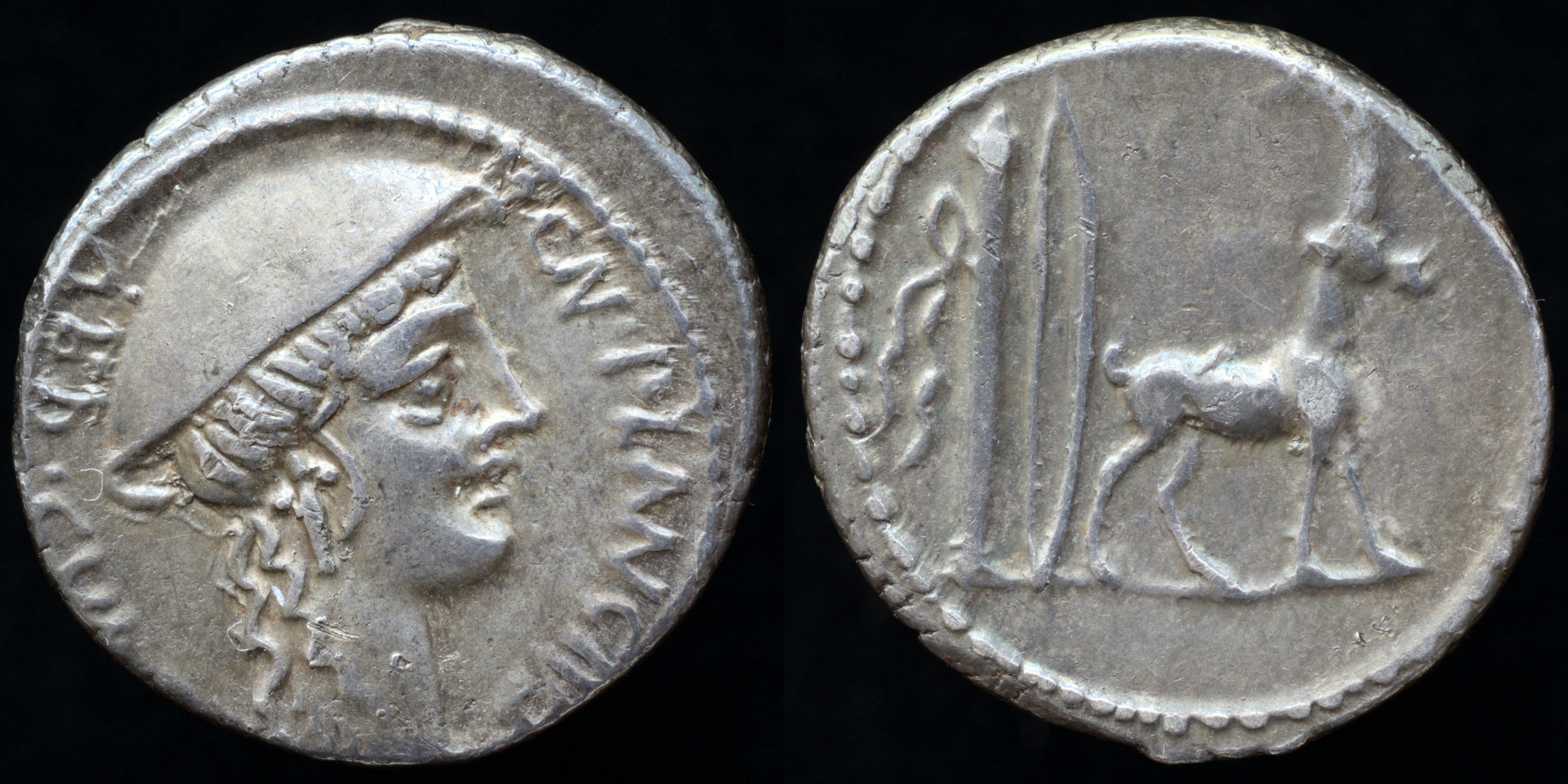
Reverse: agrimi standing right, bow and quiver left
Die Orientation: -
Weight: 4.1 g
.jpg)
Reverse: Three military trophies between capis and lituus; FAVSTVS monogram in exergue
Die Orientation: 1 H
Weight: 2.61 g
_4(0).jpg)
Reverse: Emblems of the pontificate: simpulum, aspergillum, securis (surmounted by wolf's head), and apex
Die Orientation: 10 H
Weight: 4.12 g
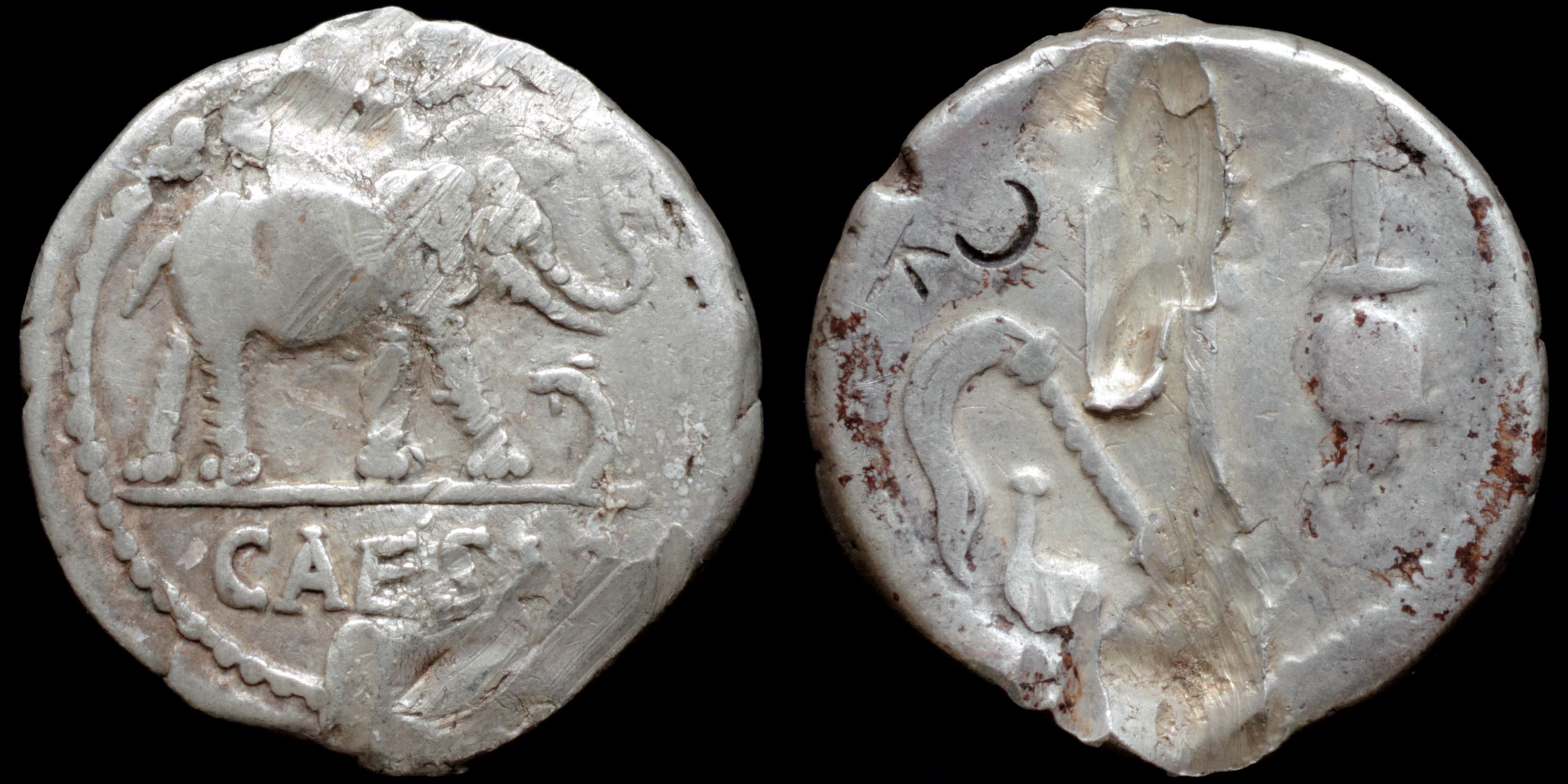
Reverse: sacrificial implements - simpulum (laddle), sprinkler, axe, apex (priest's hat)
Die Orientation: -
Weight: 4 g
moving mint (Cisalpine Gaul or Hispania). Oldschool interpretation of iconography is that elephant symbolize powerful Caesar and snake his enemies but this view must be revised. According to Harlan the Caesar's issue is reaction to the Acilius' with Salus holding snake which was in fact struck in 50 BC. Salus with snake represent health of the Republic. "Dio Cassius made it clear that the most vehement enemy of Caesar in the Senate debates of 50 was Quintus Caecilius Metellus Pius Scipio who put forward the motion that Caesar be declared a public enemy if he did not disband his troops. Caesar said that the Senate was intimated by threats from Pompey’s friends and reluctantly adopted Scipio’s proposal. Caesar put much of the blame for the civil war on Scipio who had become Pompey’s father-in-law in 52 and had shared the consulship with Pompey that year. Recounting the reasons for the civil war, Caesar was careful to avoid blaming Pompey directly and he claimed that Pompey had been led astray and corrupted (depravatum) by Caesar’s enemies who were jealous of his glory, while he himself had always promoted Pompey’s honor and dignity. …….. With a very clever, yet simple, turn on the Pompeian propaganda of Acilius’ coin, the snake has been taken from the hands of Valetudo and trampled by the Metellan elephant. Caesar showed Rome that Metellus Scipio and his supporters were the true threat to the health and safety of the Republic, the true cause of the civil war." Sacrificial implements reminds Caesar as Pontifex Maximus.
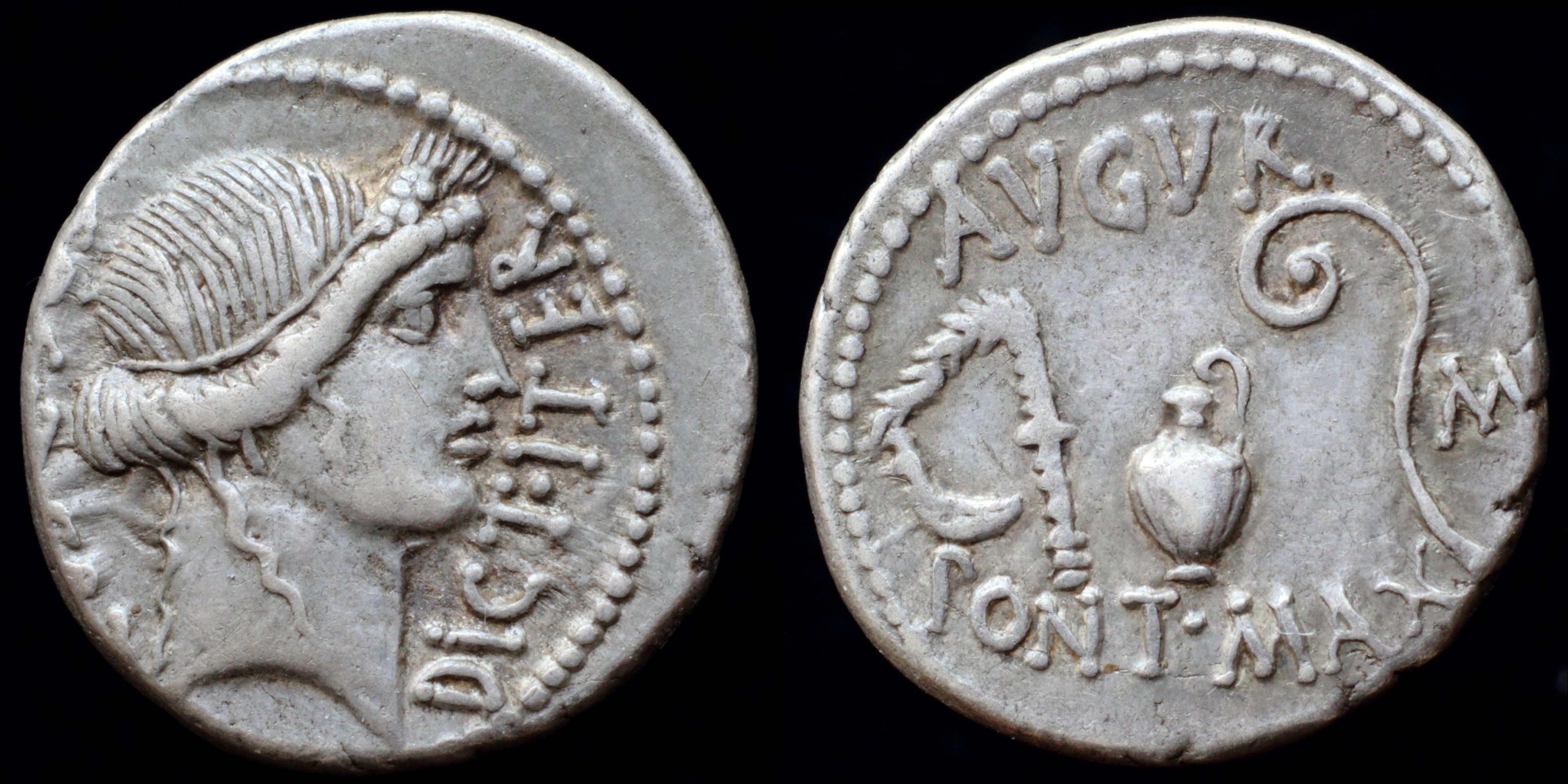
Reverse: sacrificial implements: simpulum, aspergillum, capis (jug), lituus, AVGVR / PONT·MAX / M
Die Orientation: -
Weight: 3.7 g
moving mint (Africa or Sicily). Ceres symbolizes Africa as granary of Rome. M on reverse means munus - payment for soldier's service. These coins probably served to pay Caesar's veterans after battle of Thapsus.

Reverse: Emblems of the pontificate: simpulum, aspergillum, securis (surmounted by wolf's head), and apex.
Die Orientation: 7 H
Weight: 3.82 g
.png)
Reverse: Gallic trophy, holding oval shield and carnyx; securis surmounted by wolf’s head to right
Die Orientation: -
Weight: 3.87 g
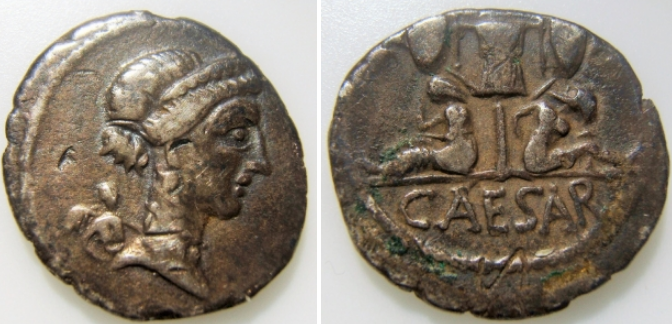
Reverse: CAESAR - Gallia and Gaulish captive seated beneath trophy of Gallic arms.
Die Orientation: 10 H
Weight: 3.46 g
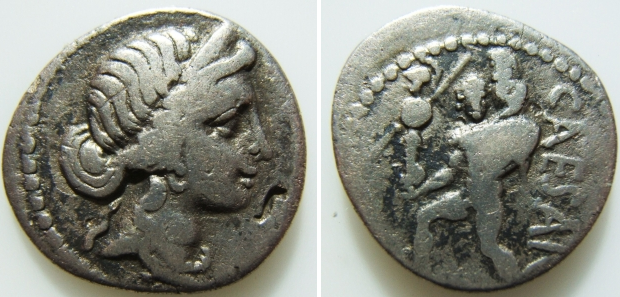
Reverse: CAESAR - Aeneas walking left, carrying Anchises and the Palladium.
Die Orientation: 6 H
Weight: 2.97 g
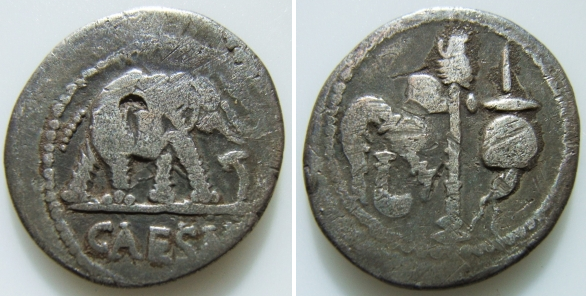
Reverse: Simpulum, sprinkler, axe and priest's hat.
Die Orientation: 3 H
Weight: 3.49 g
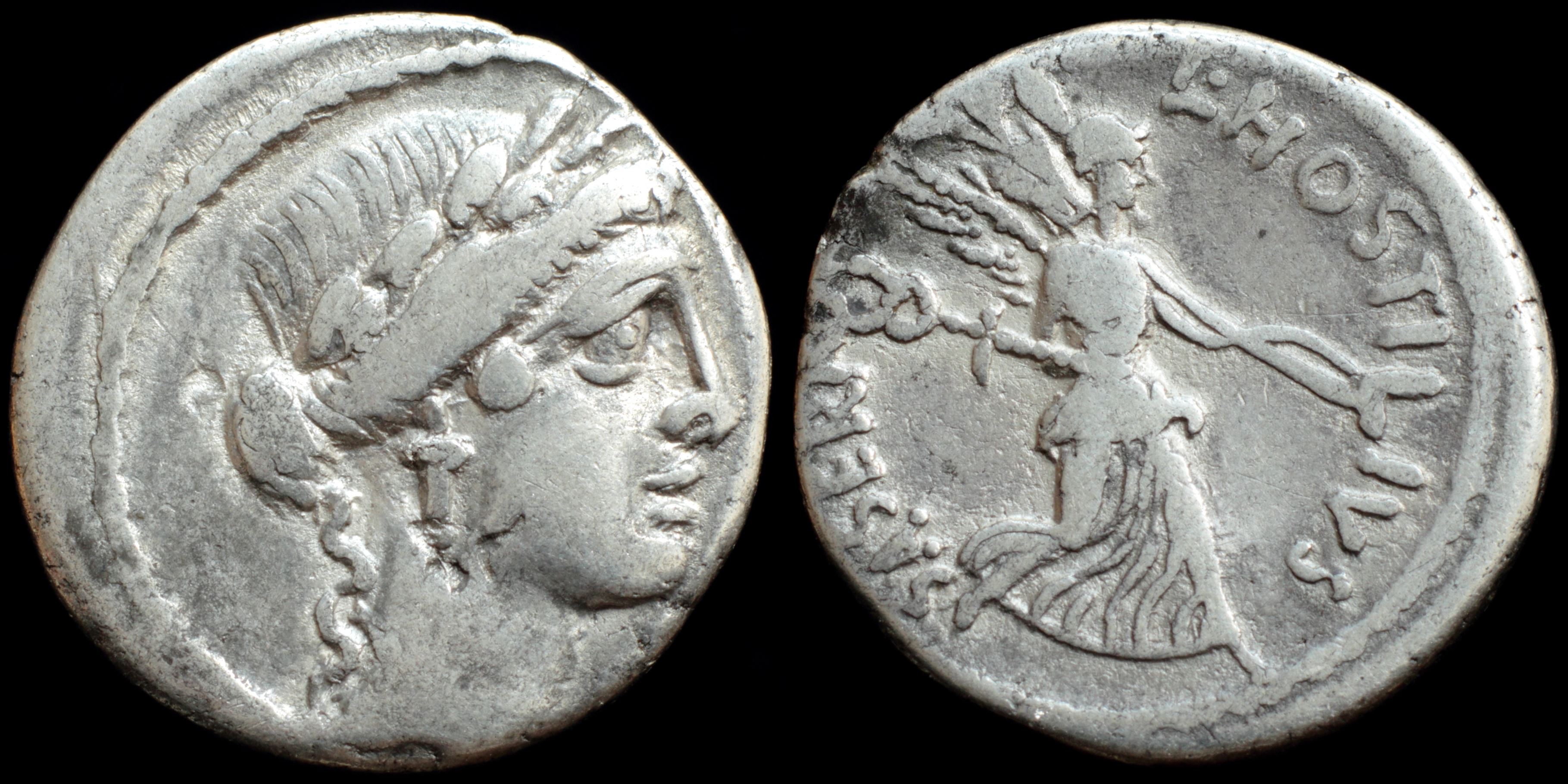
Reverse: Victory running right, holding caduceus, Gallic trophy and palm fronds, L·HOSTILI
Die Orientation: -
Weight: 3.5 g
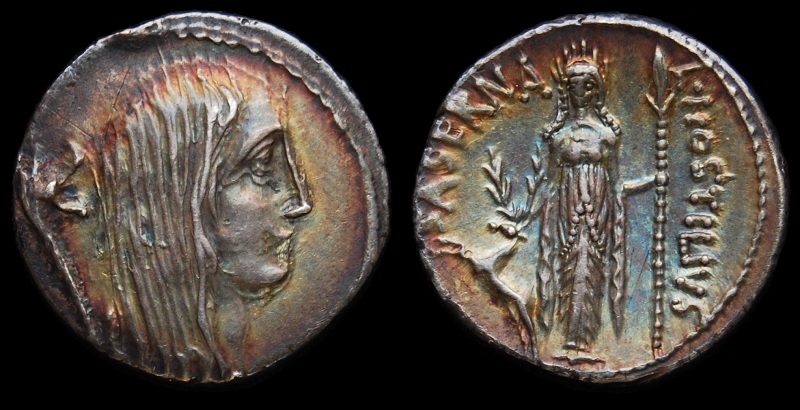
Reverse: Diana (Artemis) standing facing, laureate, wearing long hair falling down her shoulders and long flowing robes, holding spear in left hand and stag by its antlers in her right; SASERNA upward around left, L • HOSTILIVS downward to right
Die Orientation: -
Weight: 3.82 g
The obverse figure has not been definitively identified. Some speculate that she is a representation of Gallia, made to represent Julius Caesar's conquest of the area during the Gallic War. This belief is further bolstered by the presence of a carnyx behind the bust.
Another proposition is that the figure is a representation of Pallor, the goddess of fear and paleness. The complexion on the faces of different dies lend plausibility to this theory. There was another god, Pavor, who represented consternation, panic, and dread. Interestingly, Hostilius also struck a coin with a male head (who many bealieve may be a representation of the Gallic chieftain Vercingetorix). This may be an allusion to Tullus Hostilius, who vowed (and presumably later erected) temples to Pallor and Pavor during his war with the Etruscan cities Veii and Fidenae.
Another theory proposed is that Gallia is represented by Pallor, perhaps to show the fear of conquest.
The reverse probably refers to that Artemis was the chief goddess of Massalia, a Greek colony in southern Gaul. In the Civil War, Massalia declared for Pompey and Caesar besieged the city. When it submitted in 49 BC, Caesar allowed it to remain free, but took most of its lands."
Provenance: e-Bay sale (March 2018).
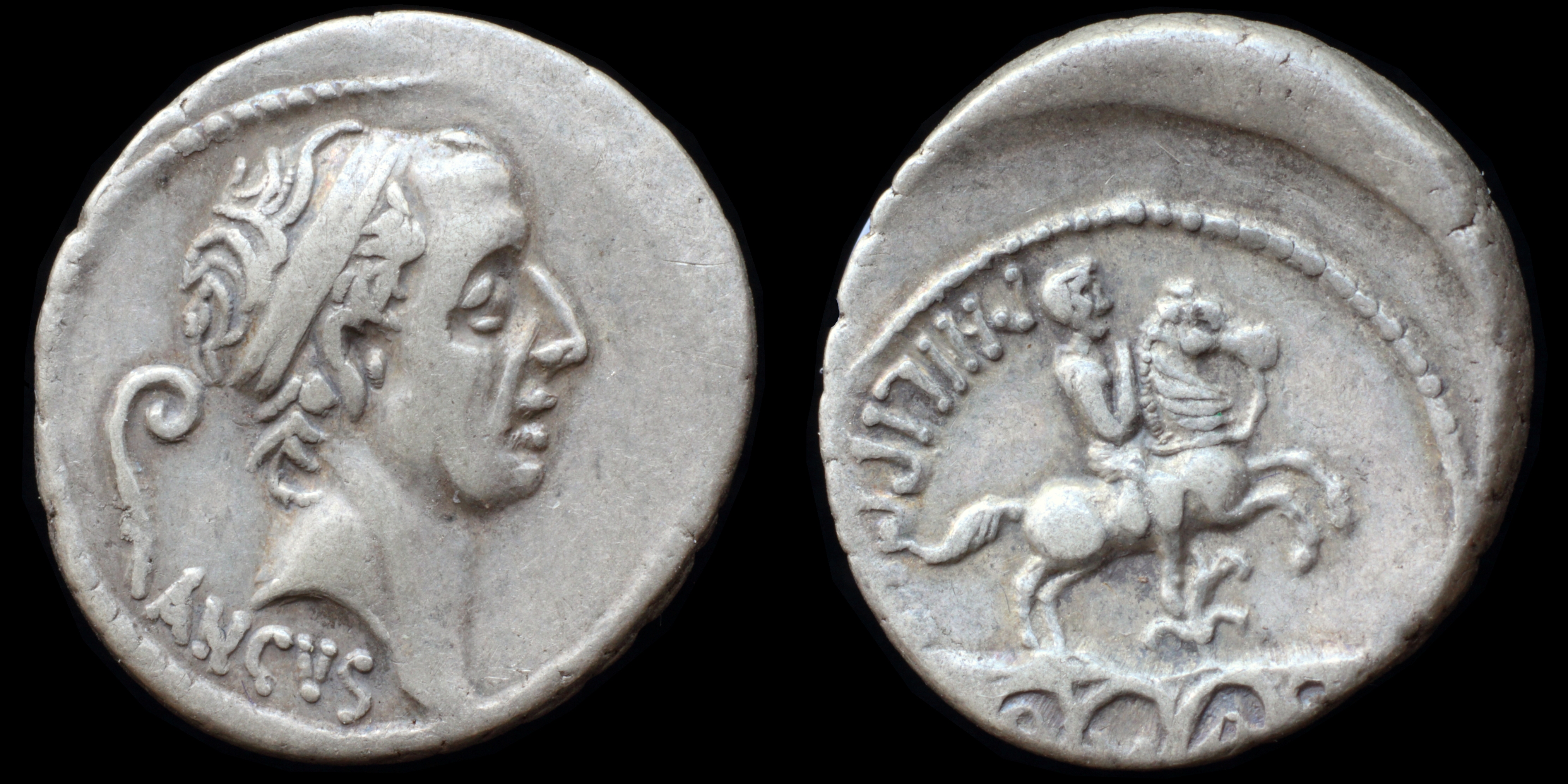
Reverse: equestrian statue right on 5 archs of aquaduct (Aqua Marcia), flower below, PHILIPPVS / A-Q-V-A-(MAR)
Die Orientation: -
Weight: 3.7 g
.jpg)
Reverse: Aqueduct on which stands equestrian statue, flower at horse’s feet; PHILIPPVS to left, AQVA MAR ligate within arches of aqueduct
Die Orientation: 3 H
Weight: 4.07 g
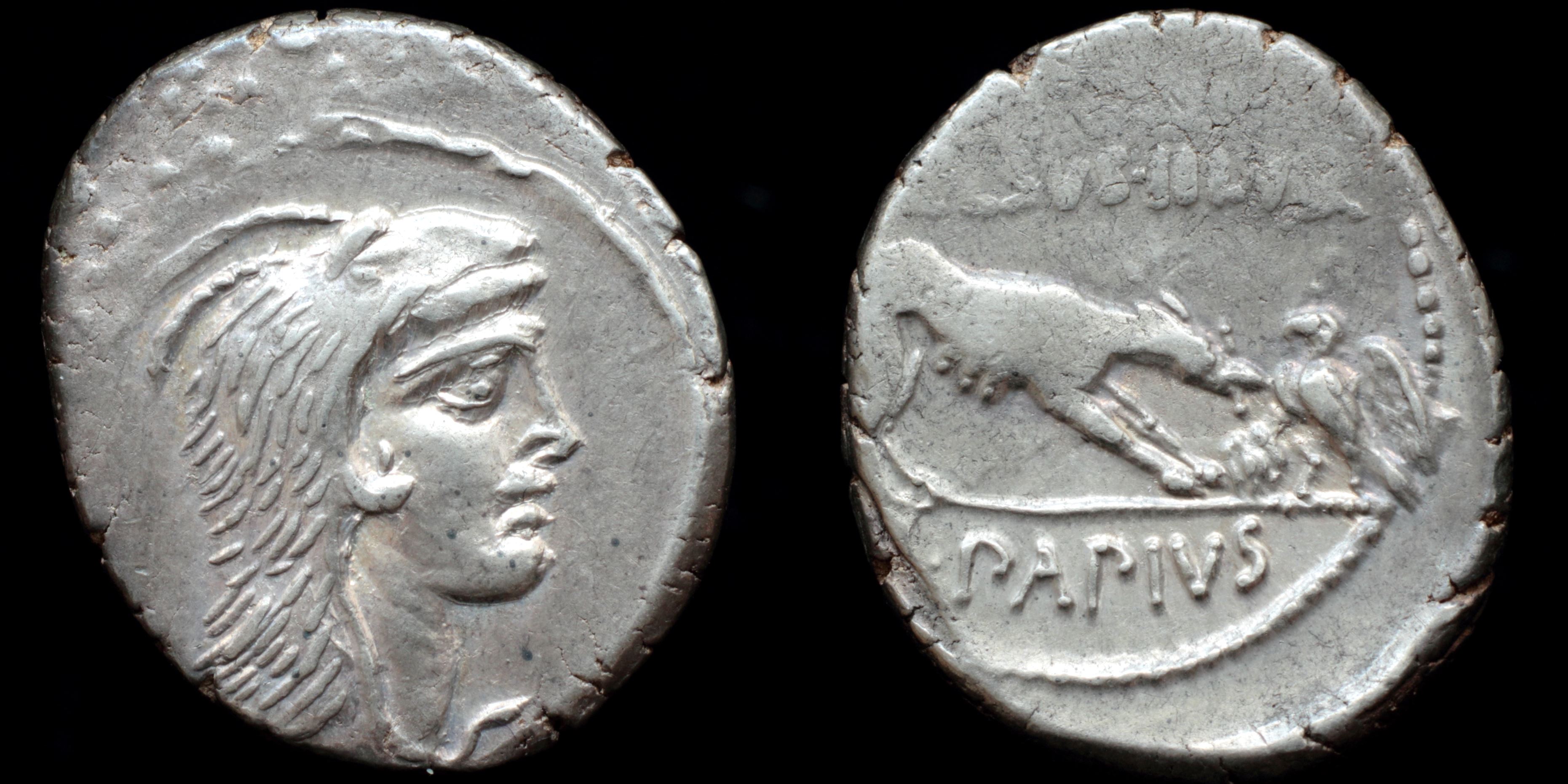
Reverse: wolf right placing stick on fire, eagle left fanning flames with its wings, CELSVS·III·VIR / L.PAPIVS
Die Orientation: -
Weight: 3.9 g
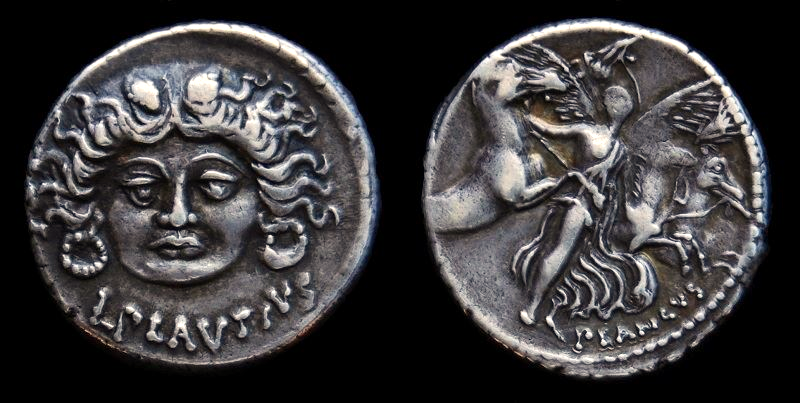
Reverse: Aurora, winged and draped, flying right, head facing slightly left, holding reins and palm branch, conducting the four rearing horses of the sun; PLANCVS below.
Die Orientation: 12 H
Weight: 4 g
Provenance: CNG Electronic auction 404 (23 August 2017), lot 453. Ex Hirsch Nachf. 284 (26 September 2012), lot 2585.
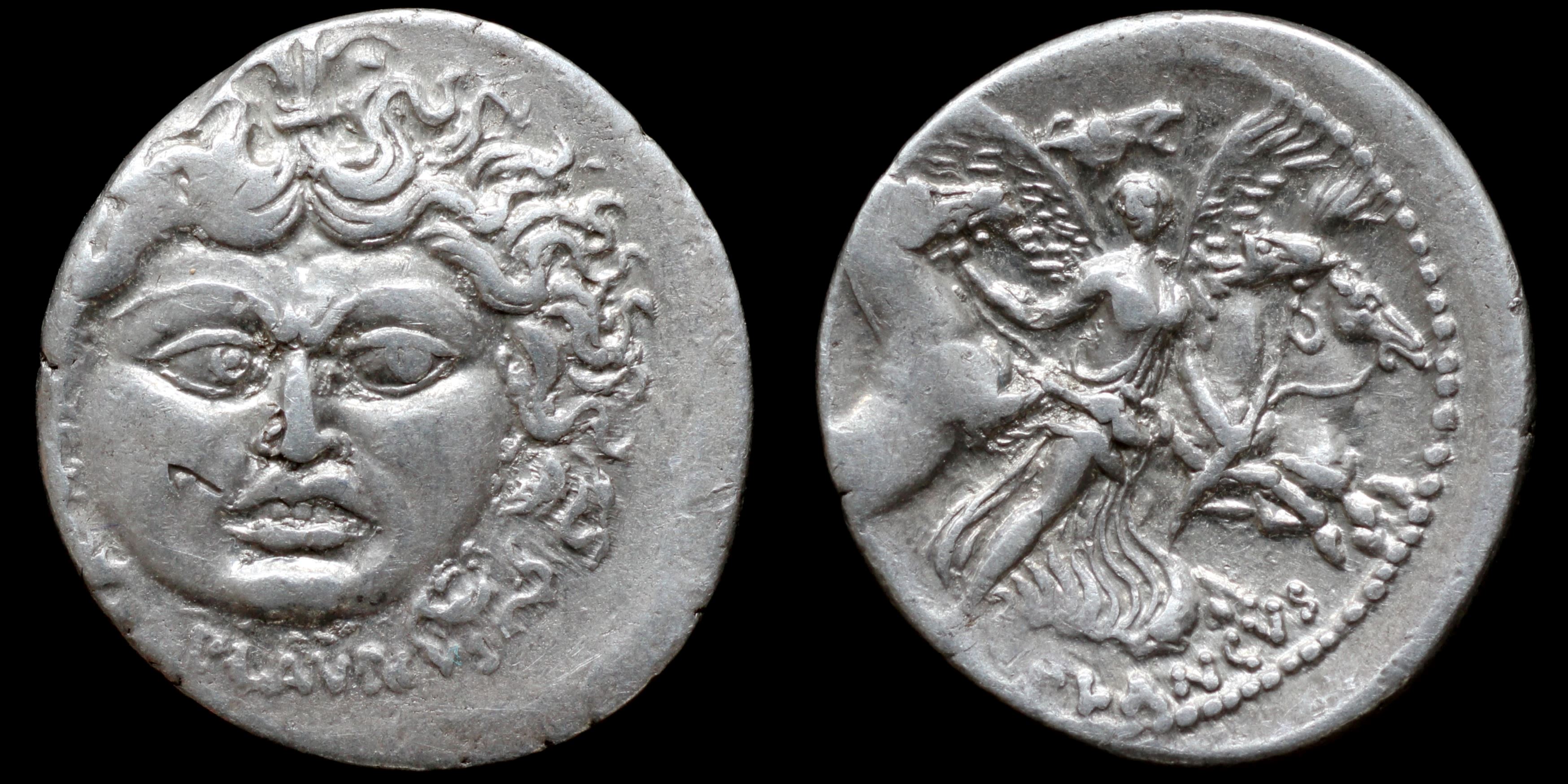
Reverse: Aurora flying right with head slightly left conducting 4 horses; PLANCVS
Die Orientation: -
Weight: 3.9 g
(16).JPG)
Reverse: Aurora flying right, conducting the four horses of the sun and holding palm frond; PLANCVS below
Die Orientation: 4 H
Weight: 3.86 g
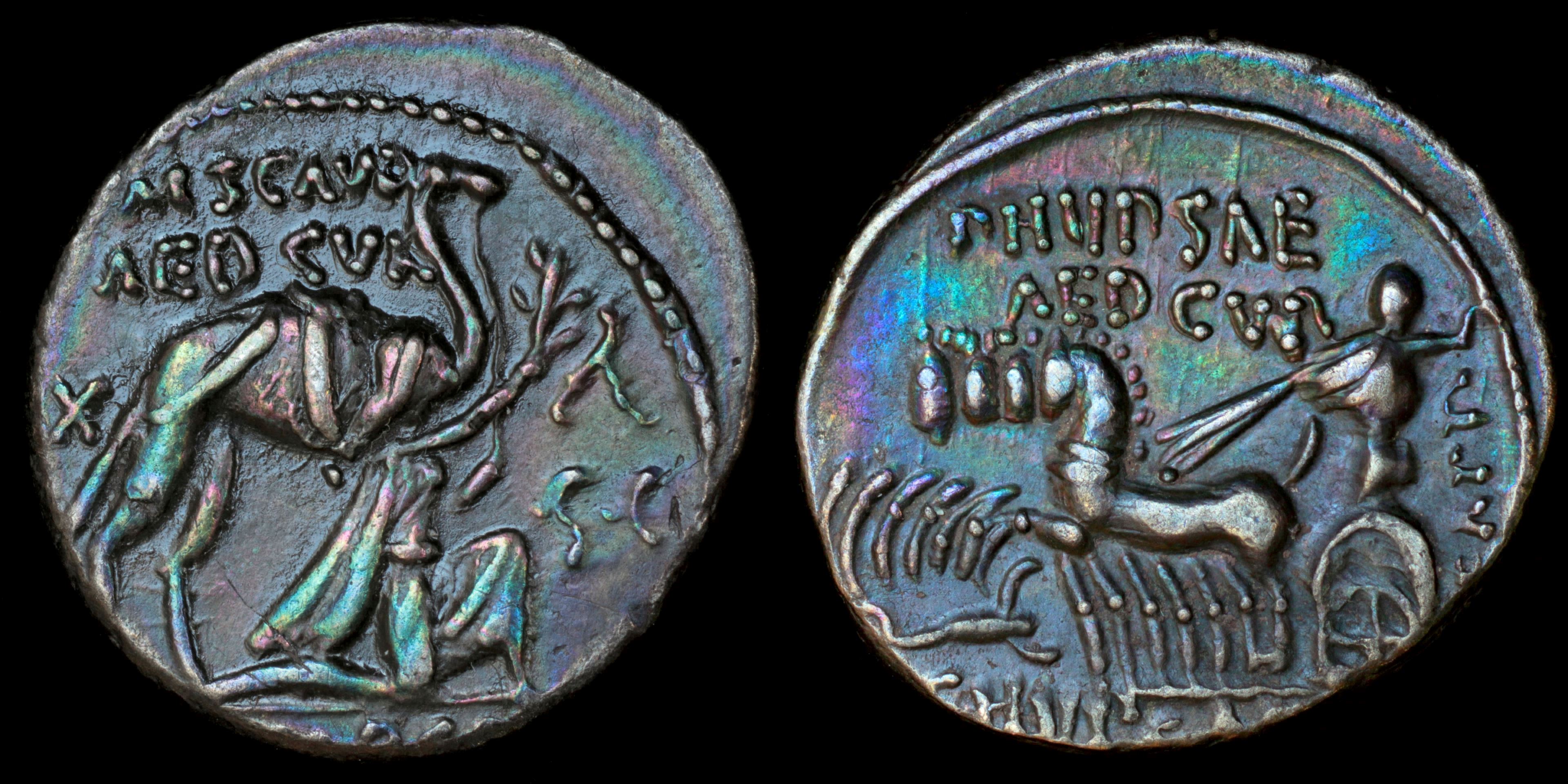
Reverse: Jupiter in quadriga left, holding reins and thunderbolt, scorpion right P HYPSAE / AED CVR / CAPT / C HYPSAE COS / PREIVE
Die Orientation: -
Weight: 4 g
.jpg)
Reverse: BRVTVS, The consul L. Junius Brutus walking left between two lictors preceded by an accensus
Die Orientation: 6 H
Weight: 3.43 g
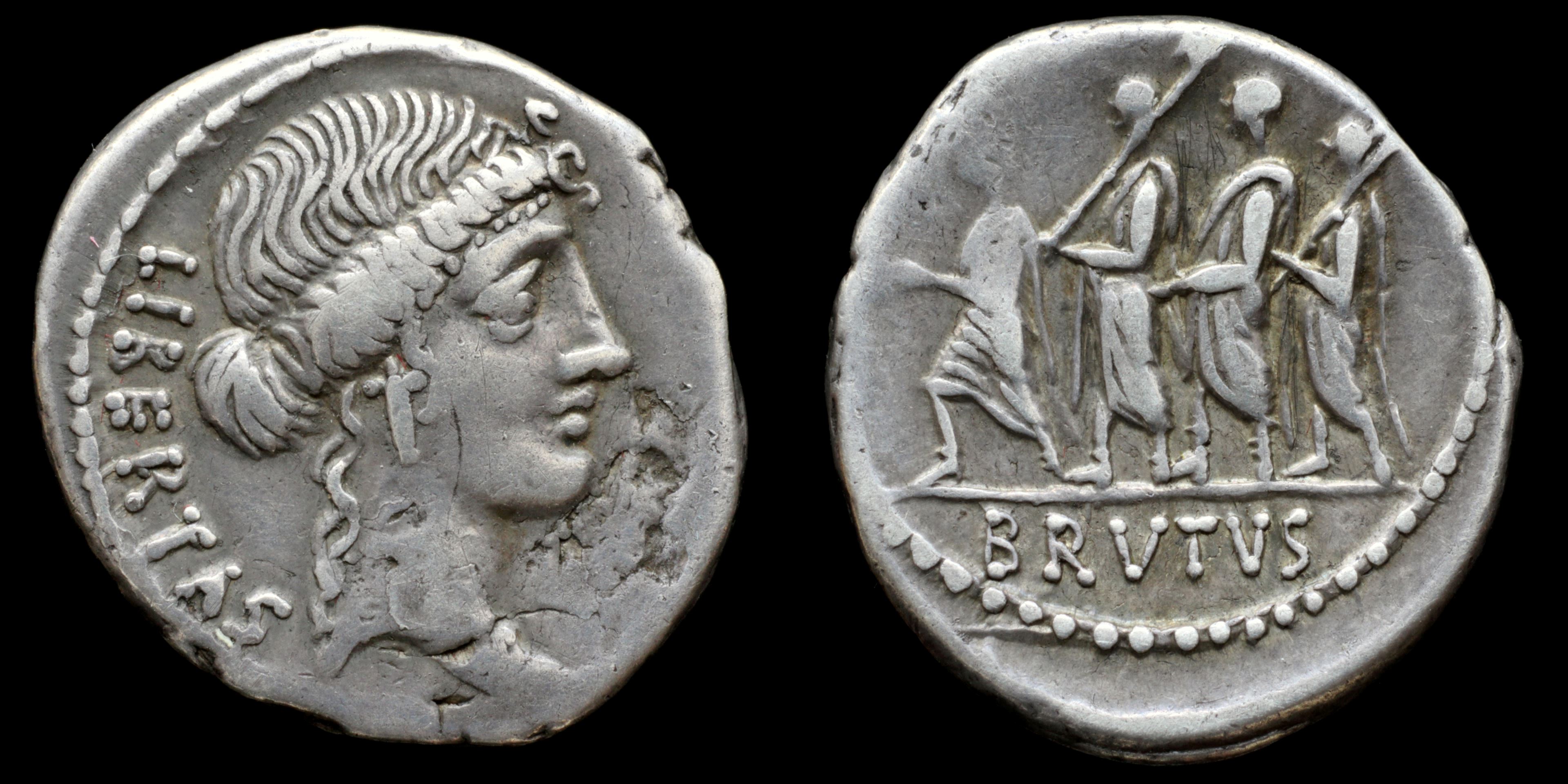
Reverse: L. Junius Brutus between two lictors left, accensus in front of them; BRVTVS
Die Orientation: -
Weight: 3.9 g
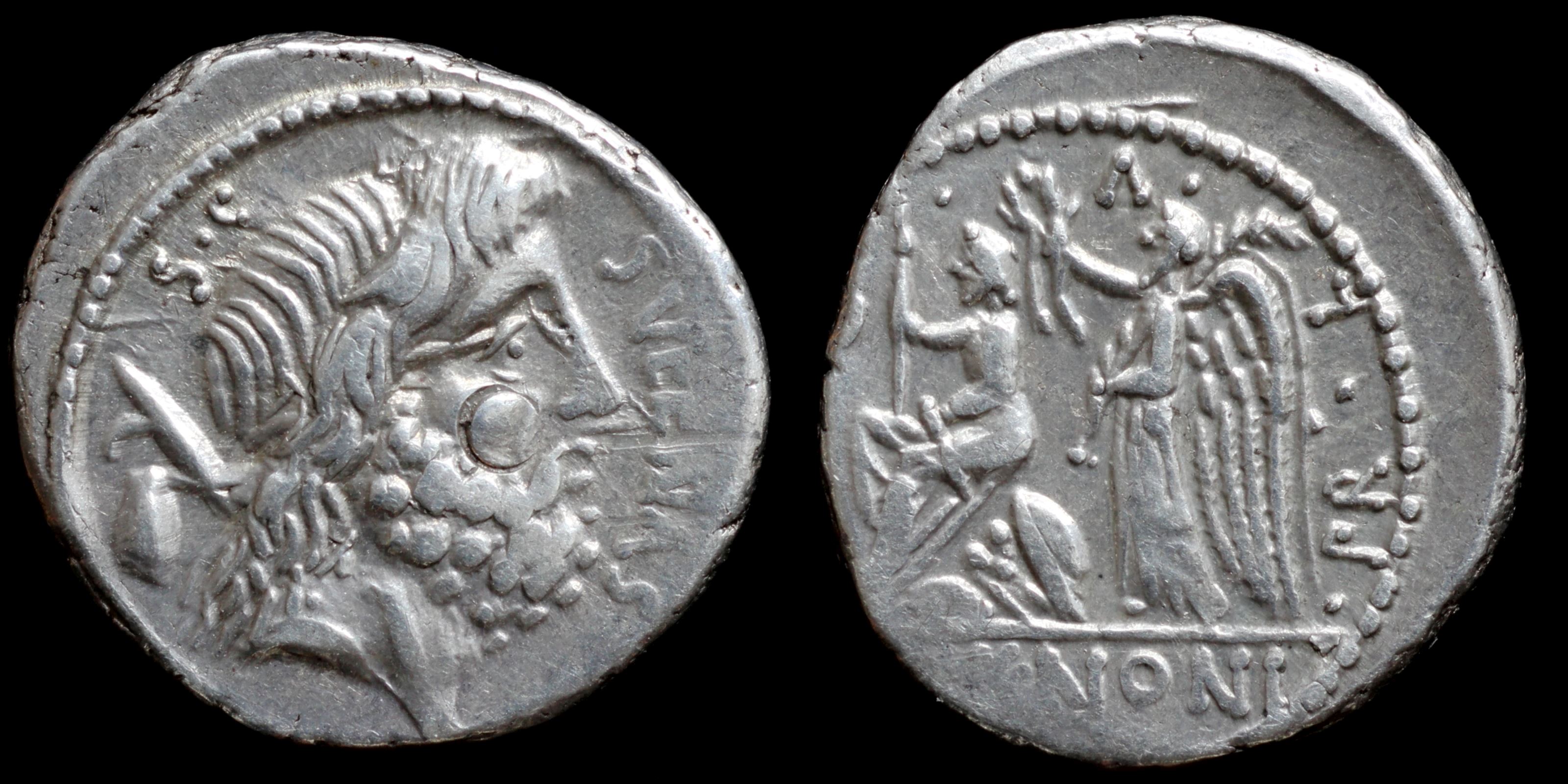
Reverse: Victory standing left holding wreath and palm, crowning Roma seated left on pile of arms holding scepter and sword; ·PR·L ·V· P·F / SEX·NONI
Die Orientation: -
Weight: 4 g
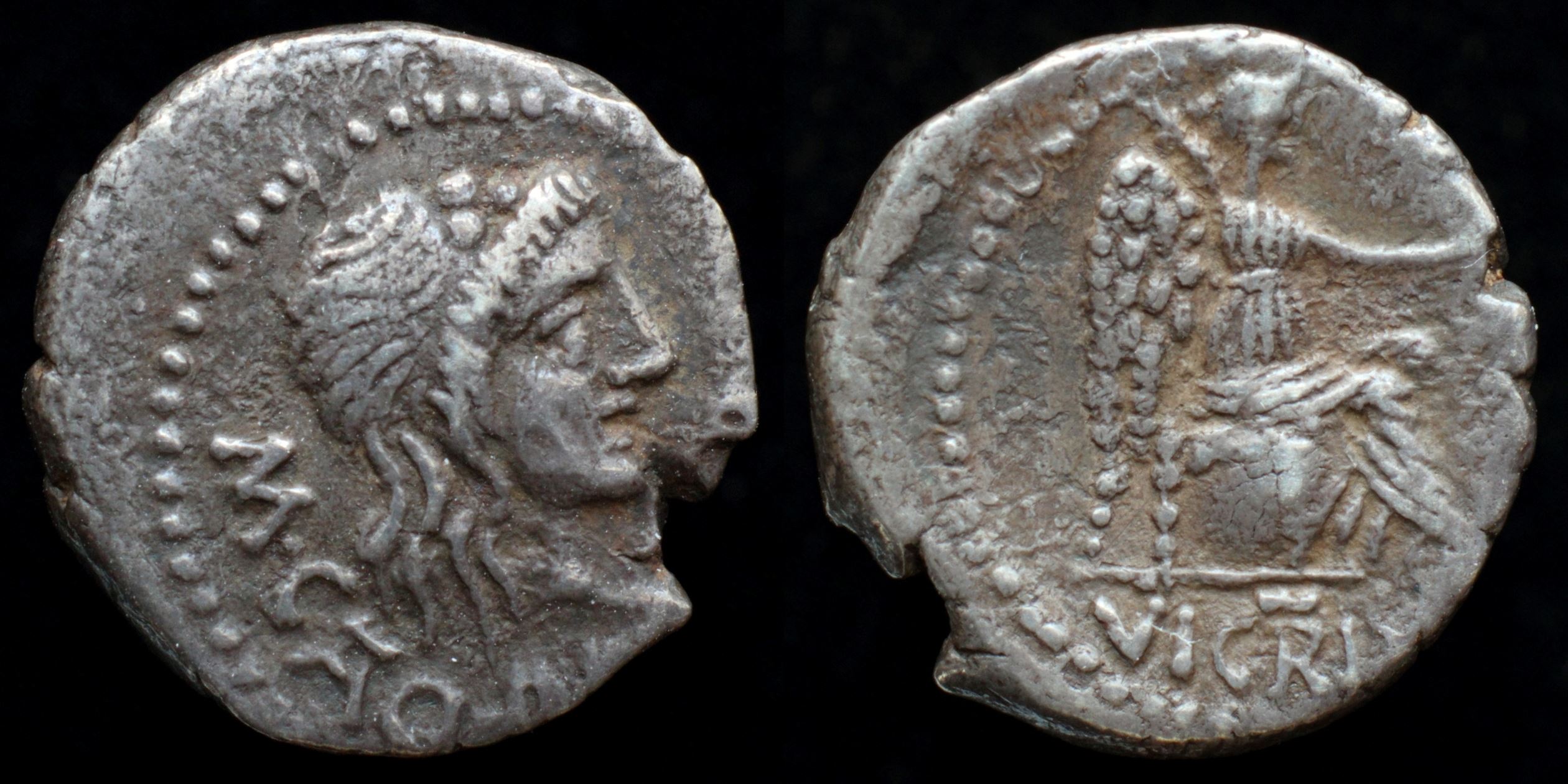
Reverse: seated Victory right holding patera and palm; VIC(TR)IX
Die Orientation: -
Weight: 1.8 g
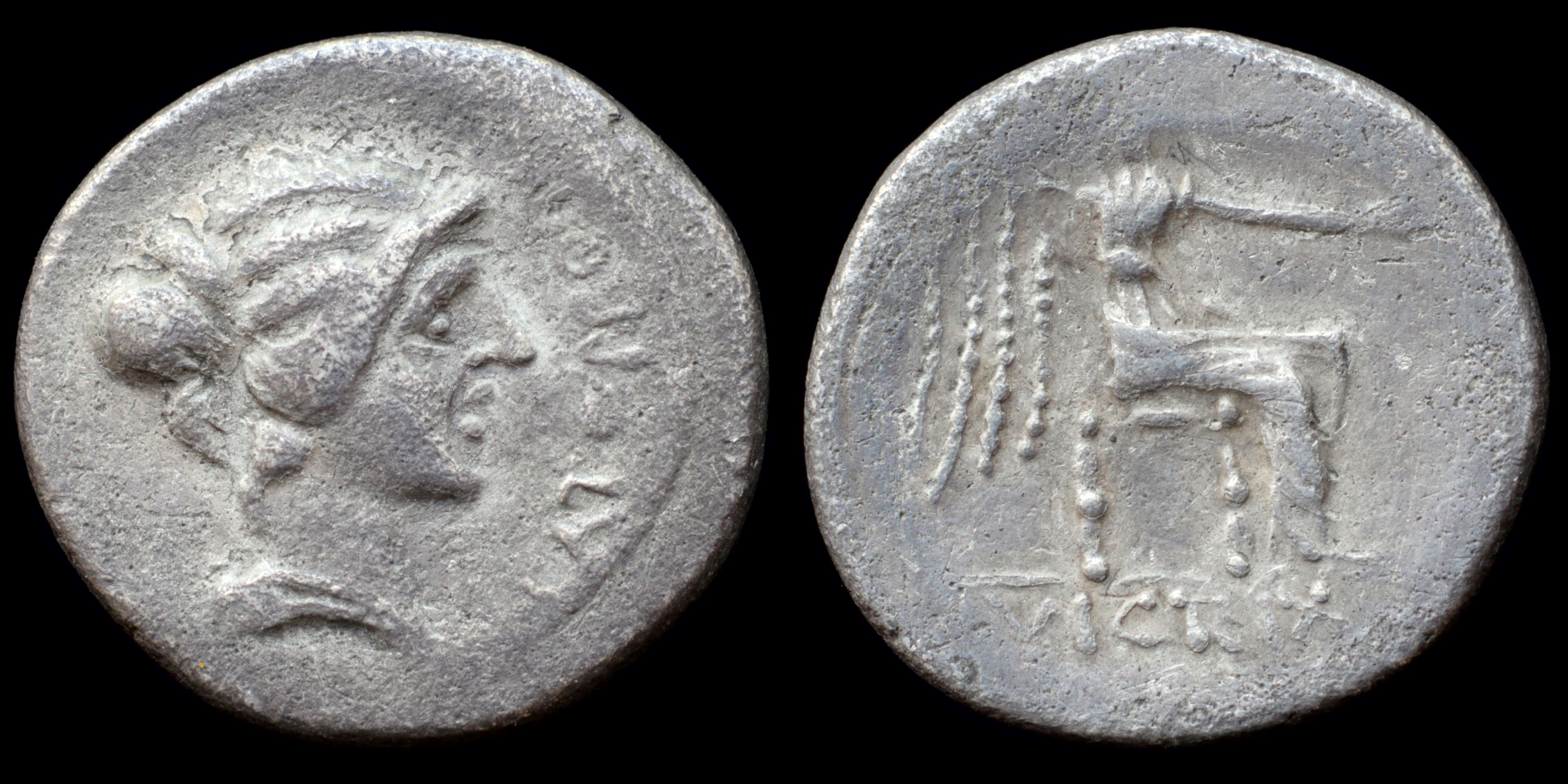
Reverse: Victory seated right, holding patera and palm; VIC(TR)IX
Die Orientation: -
Weight: 3.6 g
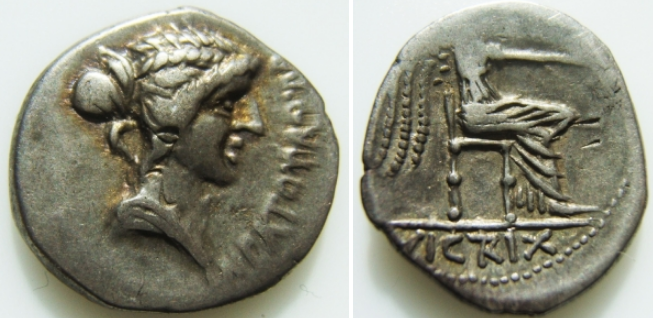
Reverse: VICTRIX - Victory seated right holding patera, VICTRIX in the ex.
Die Orientation: 3 H
Weight: 3.61 g
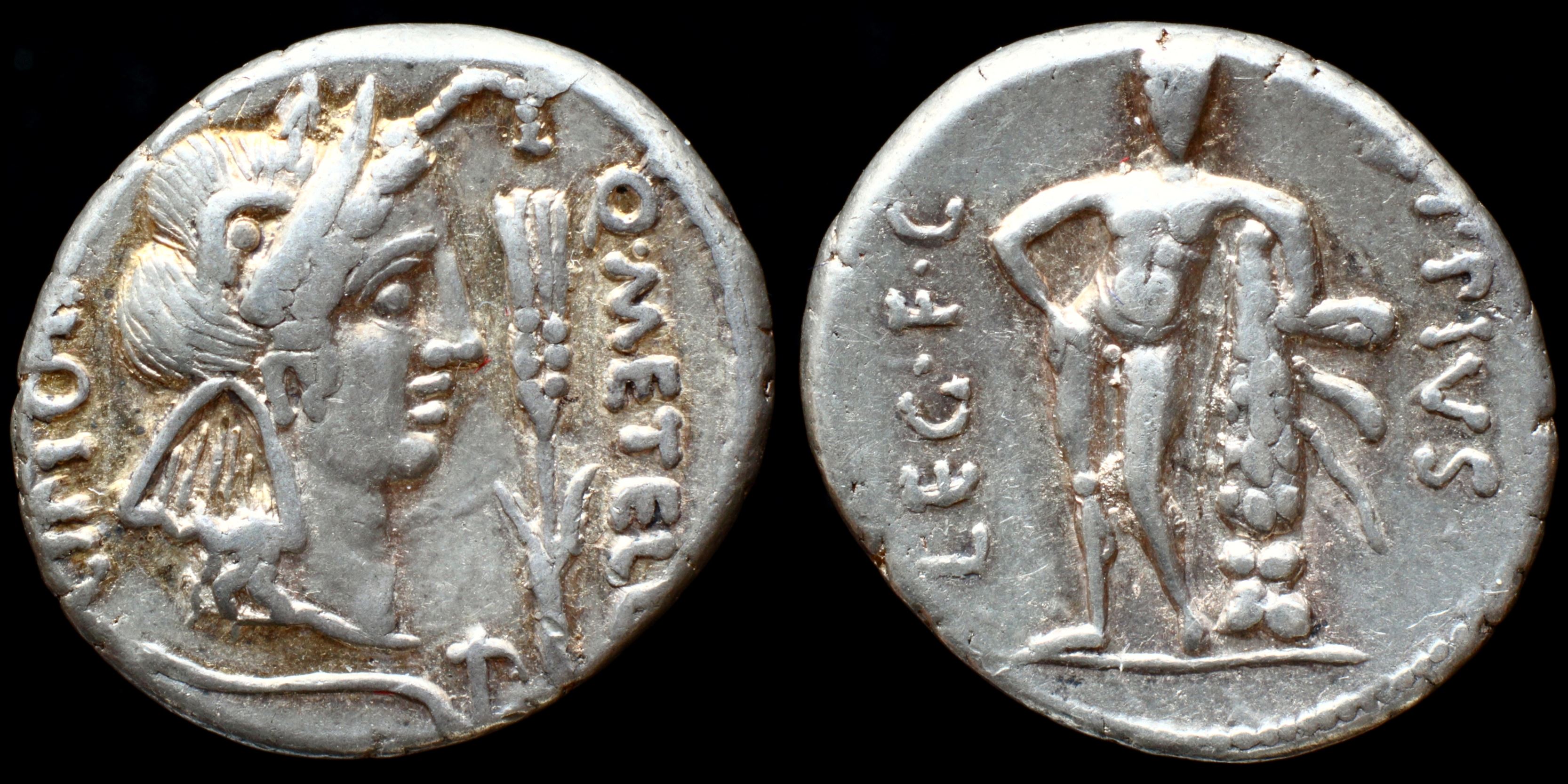
Reverse: naked Herakles facing, leaning on club set on rock draped with lion's skin; EPPIVS__LEG·F·C
Die Orientation: -
Weight: 3.8 g
.jpg)
Reverse: P CRASSVS IVN right, LEG PRO P R left - Victory standing left, holding winged caduceus in right hand, small round shield in left
Die Orientation: 12 H
Weight: 3.15 g
During the civil war between Julius Caesar and the senatorial faction led by Pompeius Magnus ("Pompey the Great"), Scipio remained a staunch optimate. He led troops against Caesar's forces, mainly in the battles of Pharsalus and Thapsus, where he was defeated. He later committed suicide. Ronald Syme called him "the last Scipio of any consequence in Roman history."
Roma Numismatics Limited has put forward the thought that it is Tanit in leontocephalic form instead of "Genius of Africa" and the "ankh" is rather the linear female abstract symbol for Tanit. I agree with the rationality behind this, because it looks everything like that symbol and nothing like an anhk, but include the standard attributions as we know them.
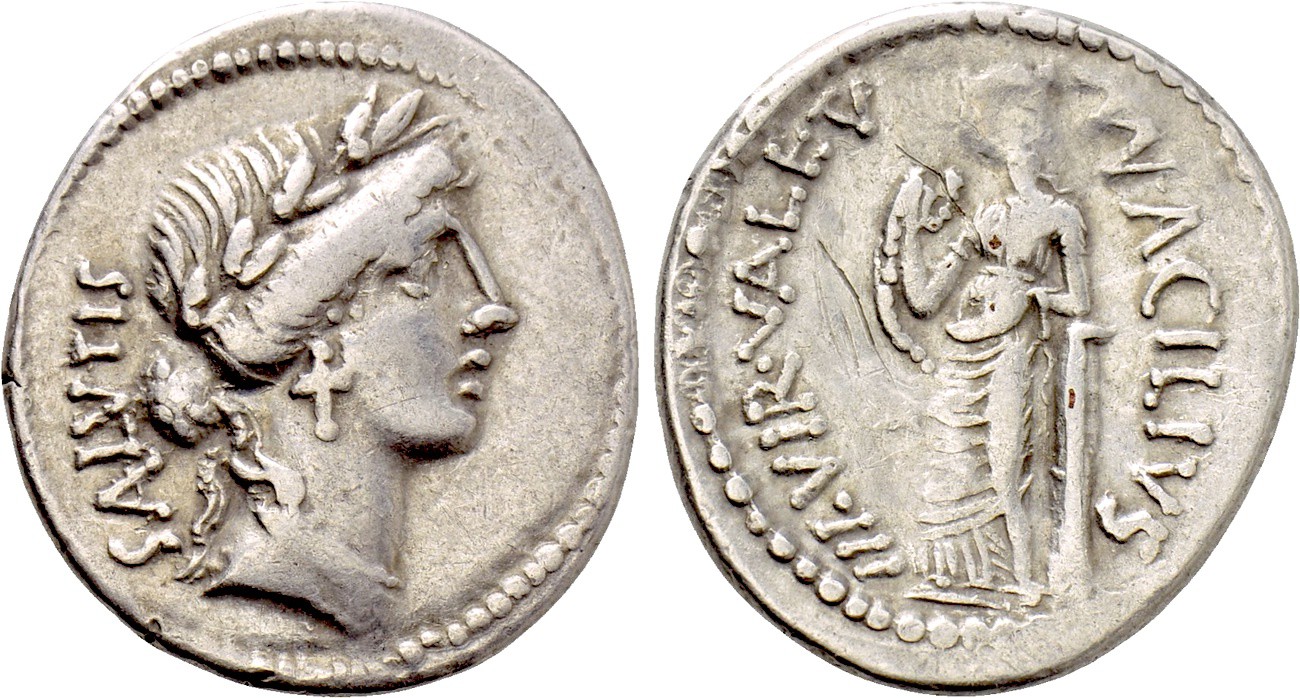
Reverse: MN ACILIVS / III VIR VALETV. Valetudo standing left, holding serpent and leaning upon column to right.
Die Orientation: 0 H
Weight: 3.34 g
(15).JPG)
Reverse: Valetudo standing left, holding snake and resting on column; MN ACILIVS III VIR VALETV around
Die Orientation: 6 H
Weight: 3.45 g
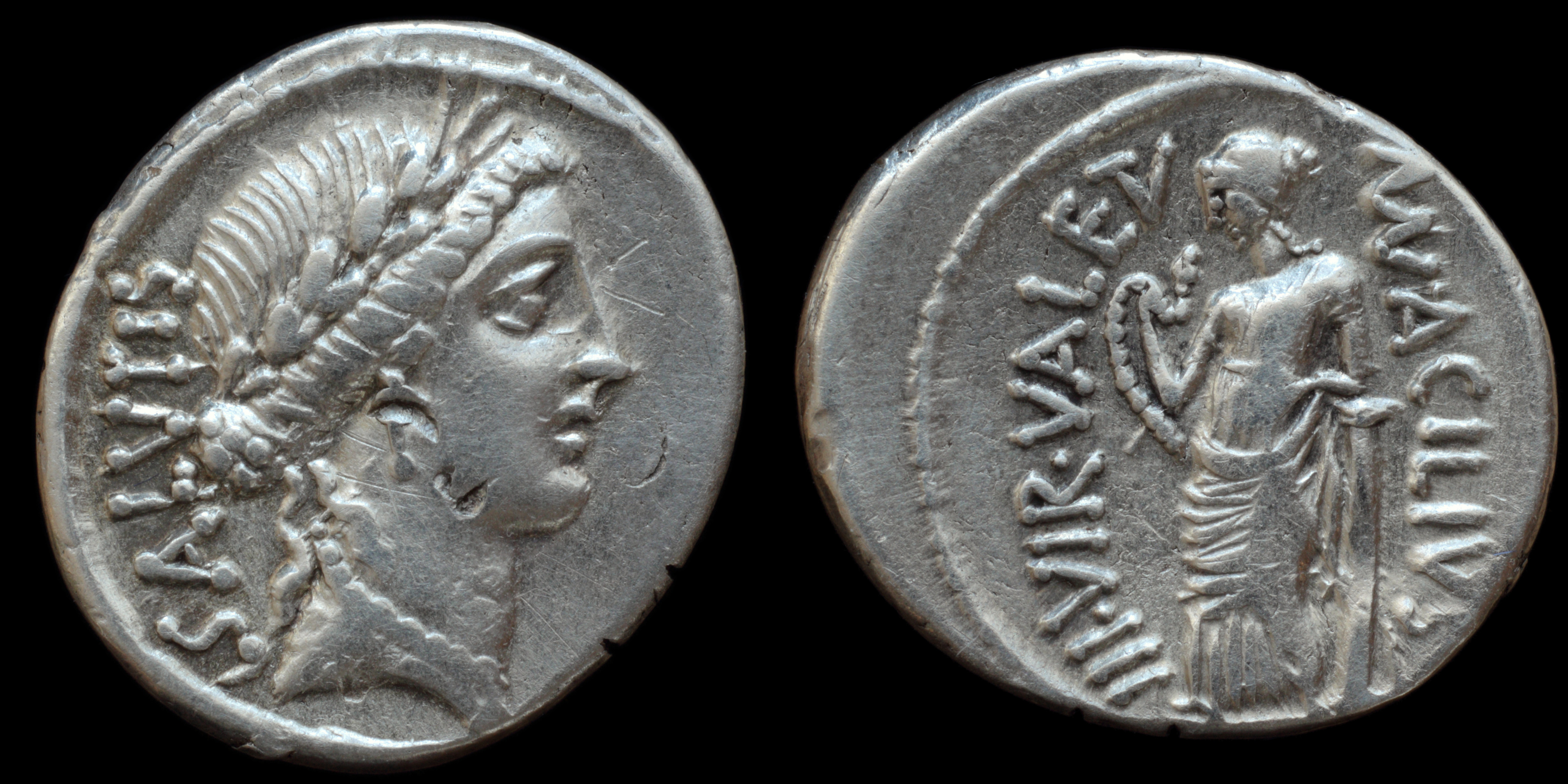
Reverse: Valetudo standing left, resting left elbow on column, holding snake; (MN)·ACILIVS__III·VIR·VALE(TV)
Die Orientation: -
Weight: 3.9 g
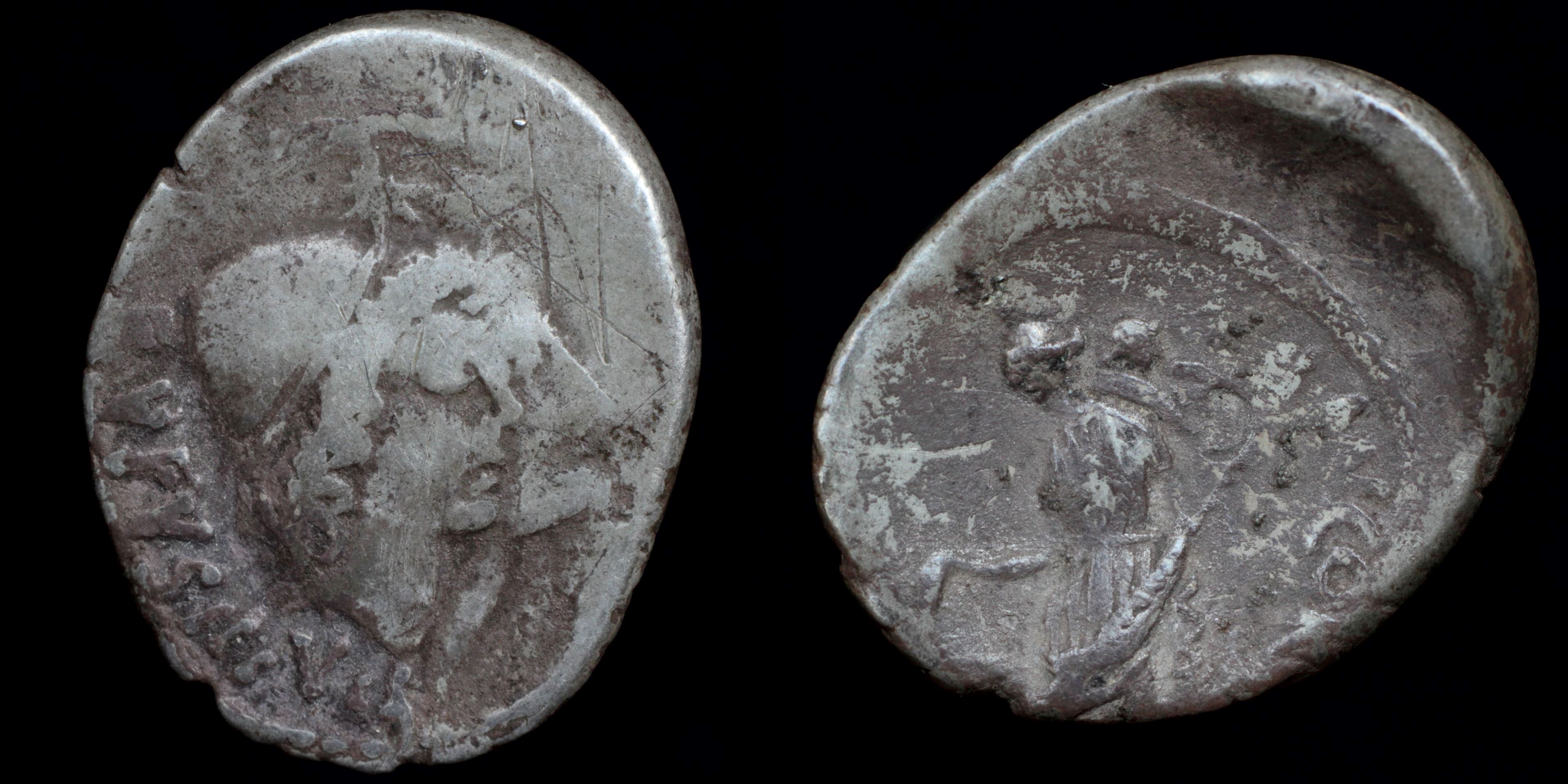
Reverse: Venus Verticordia standing left, holding scales and scepter, Cupid on her shoulder, (MN)·CORDI
Die Orientation: -
Weight: 3.65 g
.png)
Reverse: The Villa Publica: building consisting of two stories, each with a row of columns; the lower columns are surmounted by arches, the upper ones by a sloping roof - T·DIDI· IMP VIL·PVB in fields.
Die Orientation: 1 H
Weight: 3.86 g
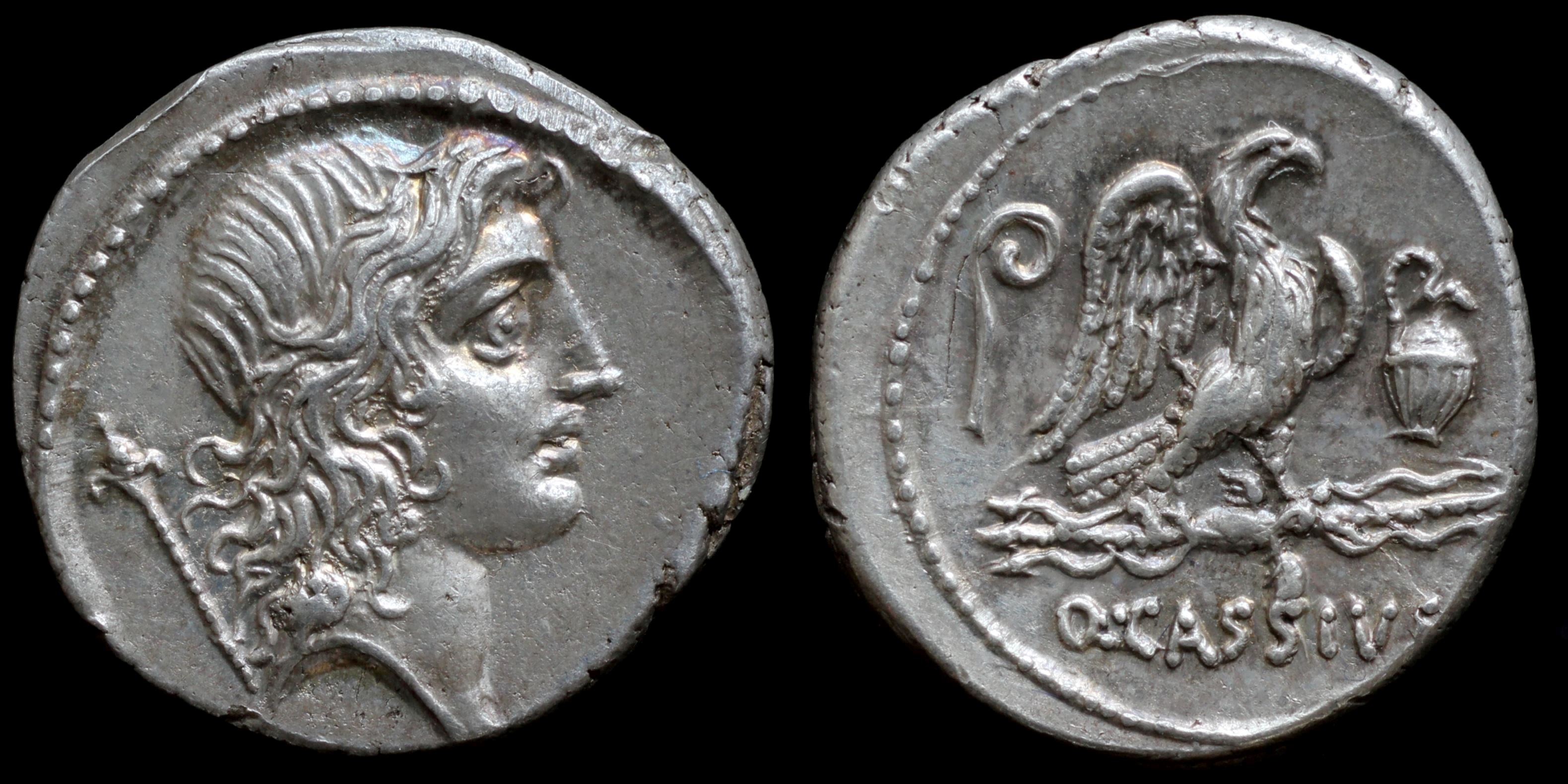
Reverse: eagle on thunderbolt right, lituus on left and jug on right, Q·CASSIVS
Die Orientation: -
Weight: 4.03 g
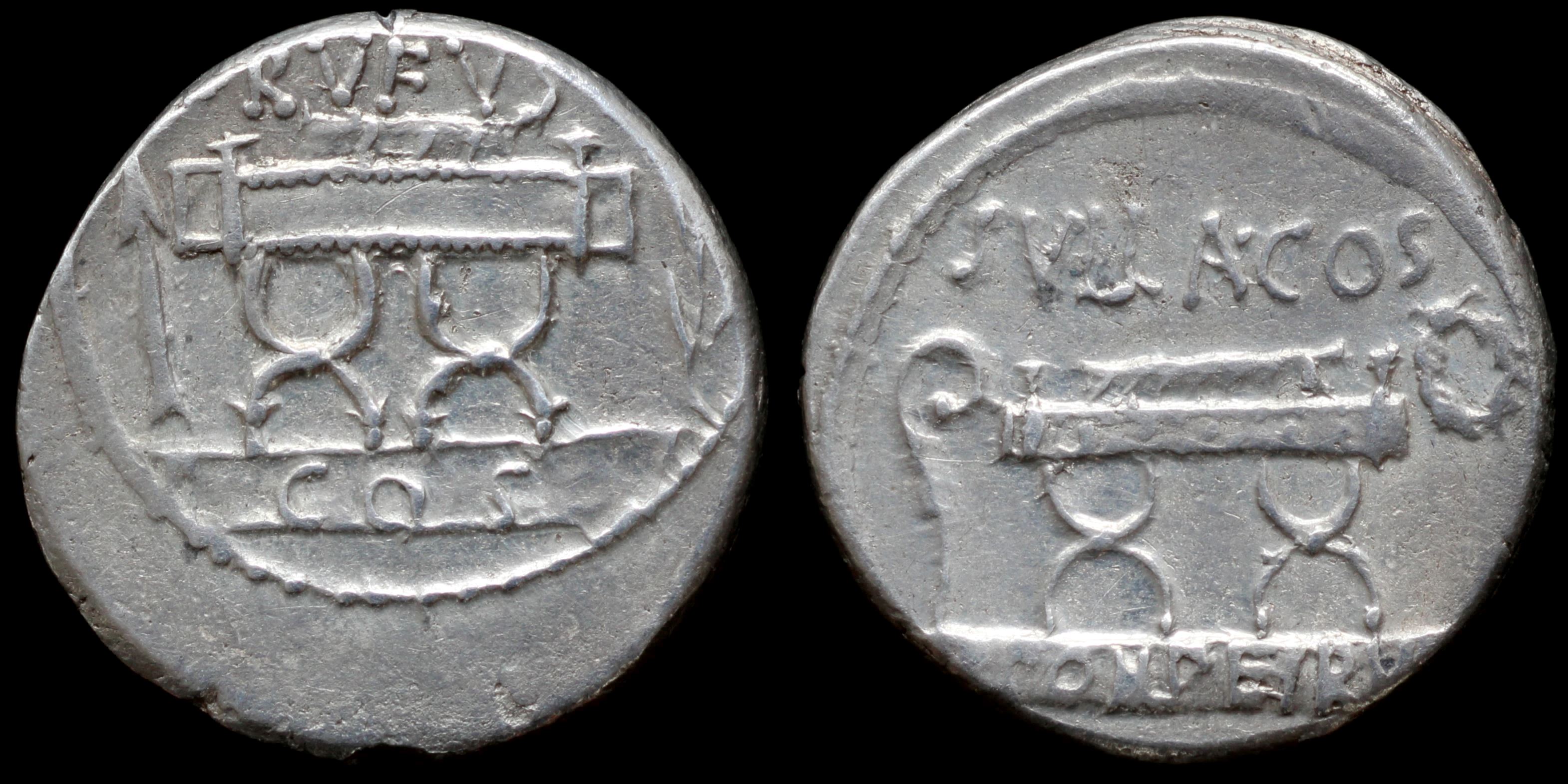
Reverse: curule chair, lituus left, wreath right; SVLLA·COS / Q·POMPEI·RVF
Die Orientation: -
Weight: 4.1 g
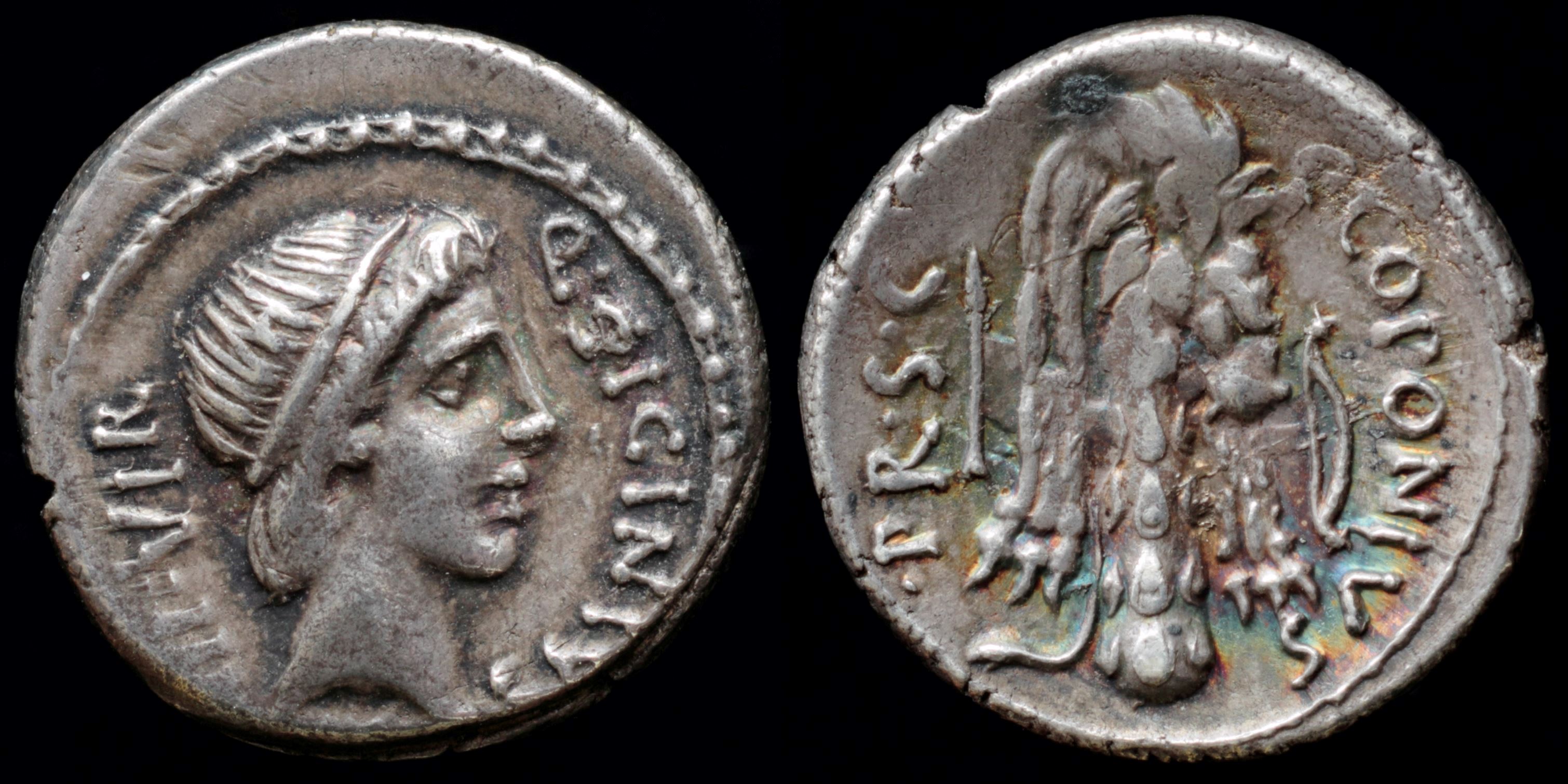
Reverse: Nemean lion's skin draped over club; arrow left; bow right, C·COPONIVS ·PR·S·C
Die Orientation: -
Weight: 3.9 g
Pompey's moving mint (Greece). Issue was probably used to pay Pompey soldiers. It mentions S·C in legend in order to pretend to be the official issue authorized by senate. Q. Sicinus struck these coins in exile in the east when he retreated with Pompey from Italy before Ceasar's invasion. Praetor C. Coponius was commander of Pompey's fleet in the easter Mediterranien. Star below Apollo may represent a comet which occured in 49 BC.
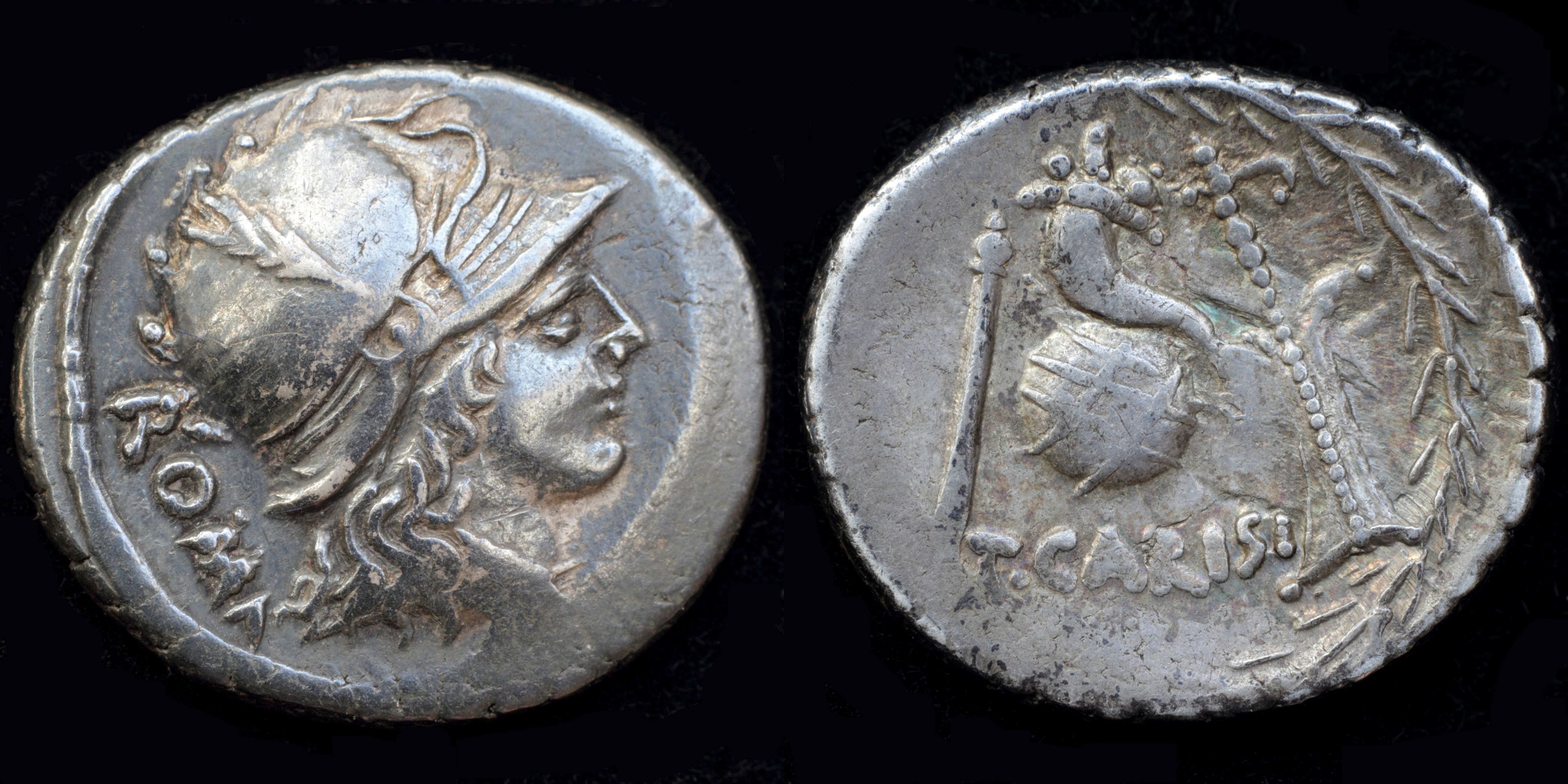
Reverse: cornucopia on celestial globe, scepter left, rudder right all within wreath, T·CARISI
Die Orientation: -
Weight: 4.3 g
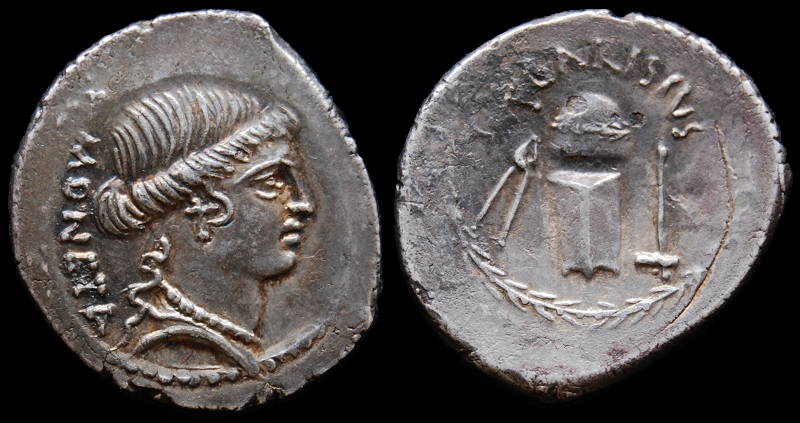
Reverse: Implements for coining money: anvil die with garlanded punch die above, tongs and hammer on either side; T•CARISIVS above; all within laurel wreath.
Die Orientation: -
Weight: 3.74 g
Provenance: Jesus Vico S.A, Auction 150 (1 March 2018), lot 414. Ex Herrero (25 March 1993), lot 78.
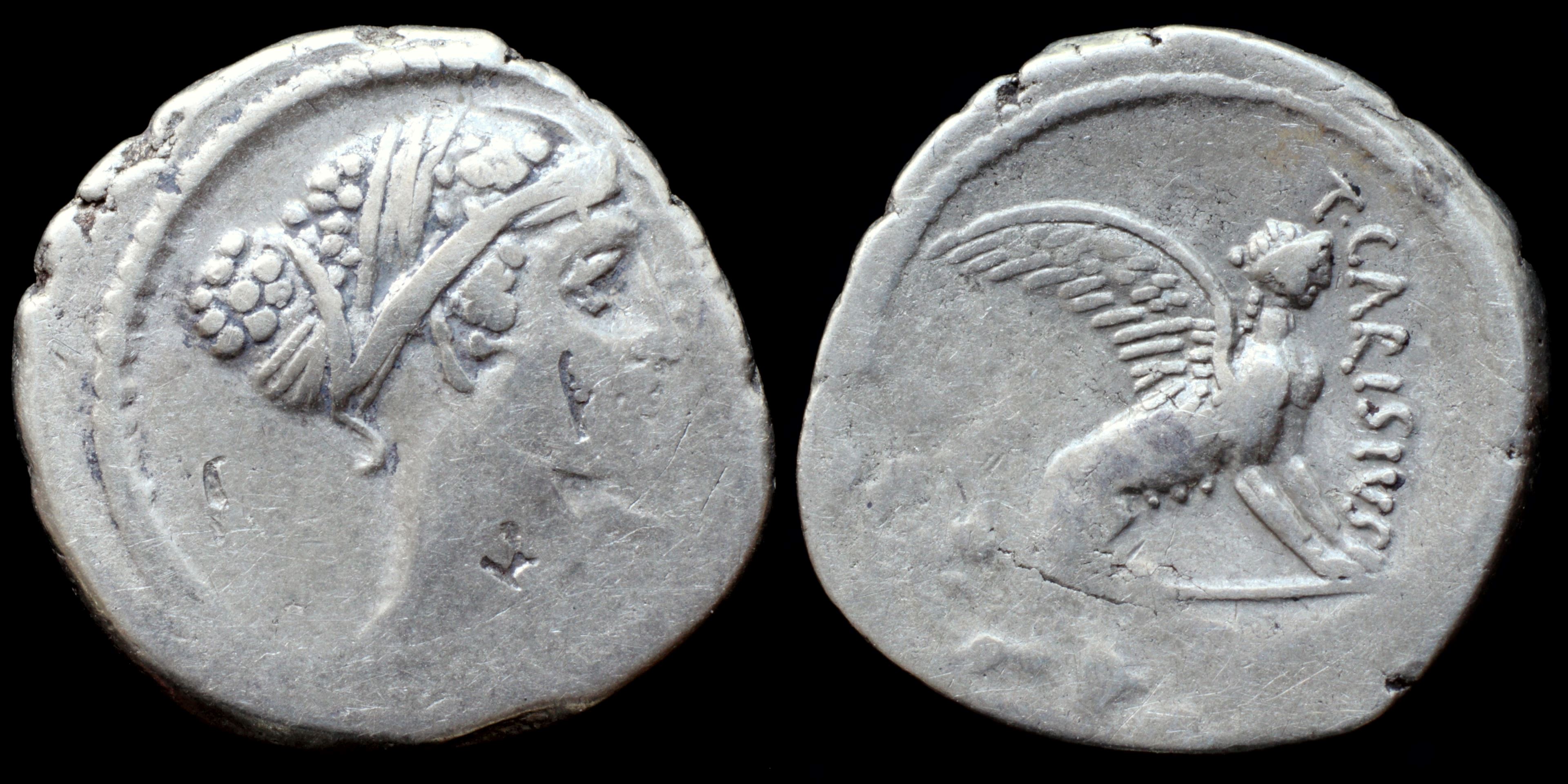
Reverse: sphinx seated right; T·CARISIVS / III·VIR
Die Orientation: -
Weight: 3.8 g

Reverse: Scepter, cornucopia on globe, and rudder; T • CARISI below; all within laurel wreath.
Die Orientation: -
Weight: 3.61 g
There are coins in which Titus Carisius is identified as triumvir monetalis, and another which mentions Publius Carisius, as legatus and propraetor, together with the word Emerita, apparently referring to the town of Augusta Emerita in Lusitania, which the emperor Augustus established for the emeriti, veterans of the war in Hispania. From this it has been conjectured that the praenomen Titus, assigned to the conqueror of the Astures by Cassius Dio, should instead be Publius.
Provenance: Triton XXII (9 January 2019), lot 912. From the Alan J. Harlan Collection, purchased from Freeman & Sear. Ex Numismatica Ars Classica 33 (5 April 2006), lot 339.

Reverse: Sphinx seated right; T • CARISIVS above, III • VIR in exergue.
Die Orientation: -
Weight: 3.8 g
Provenance: Ex Aureo & Calicó Auction 319 – Alba Longa, vol. I (7 November 2018), lot 223, Ex Sotheby's "Greek and Roman coins" (28 October 1993), lot 1385.
